|

|
|
AGENDA
Audit and Risk
Committee Meeting
|
|
Date:
|
Thursday, 19 May 2022
|
|
Time:
|
9:30 am
|
|
Location:
|
Carterton Events Centre
50 Holloway Street
Carterton
|
|
P Jones (Chair)
Deputy Chair R
Cherry-Campbell
Mayor G Lang
|
Deputy Mayor R Vergunst
Cr D Williams
Marae Representative
C Kawana
|
|
Audit
and Risk Committee Meeting Agenda
|
19
May 2022
|
5 Confirmation
of the Minutes

5.1 Minutes
of the Audit and Risk Committee Meeting held on 17 February 2022
1. Recommendation
1. That
the Minutes of the Audit and Risk Committee Meeting held on 17 February 2022
are true and correct.
File
Number: 139078
Author: Robyn
Blue, Democratic Services Officer
Attachments: 1. Minutes
of the Audit and Risk Committee Meeting held on 17 February 2022
|
Audit
and Risk Committee Meeting Minutes
|
17
February 2022
|

MINUTES
OF THE Carterton District Council
Audit and Risk Committee Meeting
HELD VIA ZOOM ON Thursday, 17 February
2022 AT 9:30 am
PRESENT: Philip
Jones (Chair), Cr Robyn Cherry-Campbell (Deputy Chair), Mayor Greg Lang, Deputy
Mayor Rebecca Vergunst, Cr Dale Williams, Charmaine Kawana
Elected
members
Cr
Steve Cretney
Other
Jacques du Toit (Audit NZ), John
Whittal (Audit NZ)
Council
staff
Geoff
Hamilton (Chief Executive), Dave Gittings (Infrastructure, Planning and
Regulatory Manager), Geri Brooking (People and Wellbeing Manager), Kelly
Vatselias (Corporate Services Manager), Jody Dalziel (Health, Safety and
Wellbeing Advisor), Melanie Barthe (Climate Change Advisor), Elisa Brown
(Communications and Engagement Advisor), Robyn Blue (Democratic Services
Officer)
1 Karakia
Timatanga
The meeting was opened with a karakia led by Charmaine
Kawana.
2 Apologies
There were no apologies received.
3 Conflicts
of Interests Declaration
There were no conflicts on interest declared.
4 Public
Forum
There was no public forum.
5 Confirmation
of the Minutes
|
5.1 Minutes
of the Audit and Risk Committee Meeting held on 17 November 2021
|
|
MOVED
1.
That the minutes of the Audit and Risk Committee Meeting held on 17
November 2021 are true and correct.
Cr D Williams / Cr R
Cherry-Campbell
CARRIED
|
6 Reports
|
6.1 Audit
New Zealand Report on the 2020/21 Annual Report
|
|
1. Purpose
To
present the report prepared by Audit New Zealand on the 2020/21 Annual Report
for the Committee’s consideration.
|
|
NOTED
John Whittal presented the
Audit NZ report on the 2021 Audit.
MOVED
That the Committee:
1. Receives
the report.
2. Notes
the management comments.
Cr R Cherry-Campbell / Mayor G Lang
CARRIED
|
|
6.2 Progress
update on Audit NZ Recommendations
|
|
1. Purpose
The purpose of this
paper is to update the Committee on the progress achieved to date responding
to the recommendations presented by Audit NZ, arising from their previous
audits.
|
|
MOVED
That the Committee:
1. Receives
the report.
2. Notes
the progress being made to meet the recommendations made by Audit New
Zealand.
Chair P Jones / Cr R
Cherry-Campbell
CARRIED
|
|
6.3 Proposed
Audit and Risk Committee schedule for 2022 year
|
|
1. Purpose
For the committee to
review and amend/make comment to the proposed work programme contained below.
|
|
NOTED
·
The
Governance Review will be added to the Audit and Risk Committee Schedule
(May), then a full Council meeting.
·
The
Corporate Services Manager is reviewing the non-financial reporting measures
which will come to an Audit and Risk Committee meeting, then a full Council
meeting.
·
It was recommended
that the full Risk Register is reviewed annually, but the top 5-10 risks are
reported on in more detail at each Audit and Risk Committee meeting and also
changes to any other risks.
MOVED
That the Committee:
1. Receives
the report.
Deputy Mayor R
Vergunst / Cr R Cherry-Campbell
CARRIED
|
|
6.4 Treasury
Update Report
|
|
1. Purpose
The purpose of the
report is to provide the Committee with an update on council’s current
Treasury position.
|
|
NOTED
As
agreed by Council, Price Waterhouse Cooper have been engaged for Treasury
management services. They will be invited to attend the May Audit & Risk
Committee meeting with a workshop held prior.
MOVED
That the Committee:
1. Receives
the report.
2. Notes
the current Treasury position and compliance with policy.
Cr D Williams / Deputy
Mayor R Vergunst
CARRIED
|
|
6.5 Risk
Register Update
|
|
1. Purpose
To advise
the Audit and Risk Committee on changes to the Carterton District Council
Risk Register
|
|
NOTED
The
risks associated with climate change need more discussion at a workshop
before the various risks and their rating are included in the Risk Register.
The focus with climate change is on what Council can do.
MOVED
That the Committee:
1.
Receives the report.
2.
Note climate change will be on the agenda of the next Audit and
Risk Committee meeting.
Chair P
Jones / Deputy Mayor R Vergunst
CARRIED
|
|
6.6 Government
Reform Update
|
|
1. Purpose
For the Committee to
receive an update on Central Government’s reform changes impacting upon
Local Government.
|
|
MOVED
That the Committee:
1. Receives
the report.
Cr R Cherry-Campbell / Deputy Mayor R Vergunst
CARRIED
|
|
6.7 Project
Reviews Update - Expression of Interest
|
|
1. Purpose
To update the
Committee on progress of the Expression of Interest (EOI) for the project
reviews of the Clocktower Project and Wastewater Reservoirs Project.
|
|
MOVED
That the Committee:
1. Receives
the report.
2. Notes
the next update will be brought back to the Audit and Risk Committee on
19 May 2022.
Chair P Jones / Mayor G Lang
CARRIED
|
|
6.8 Health,
Safety & Wellbeing Update
|
|
1. Purpose
This report updates the Audit
and Risk Committee on recent health, safety and wellbeing (HS&W)
activities.
|
|
NOTED
the current focus with the
Health, Safety and Wellbeing team is on managing risk with the Omicron
outbreak. Sixteen staff are identified as critical workers who have access to
Rapid Antigen Testing from the DHB until CDC stock arrives.
MOVED
That the Committee:
1. Receives
the report.
Cr R Cherry-Campbell / Cr D Williams
CARRIED
|
7 Karakia
WhakamUtunga
The meeting was closed with a karakia led by Charmaine
Kawana.
The meeting closed
at 11.05 am
Minutes confirmed:
……………………………………
Date: ...................................................
|
Audit
and Risk Committee Meeting Agenda
|
19
May 2022
|
6 Reports

6.1 Independent
Review of the Clocktower and Wastewater Treatment Ponds Projects
1. Purpose
To update the Committee on the outcome of the independent review of the project management process used for the
delivery of the Clocktower and Wastewater Treatment Reservoir Pond projects.
2. Significance
The matters for decision in this
report are not considered to be of significance under the Significance and
Engagement Policy.
3. Background
Carterton District Council engaged
with external consultant Calibre Consulting Ltd to undertake an independent
review [see Attachment 1] of the project management process used for the
delivery of the Clocktower and Wastewater Treatment Reservoir Pond project (up
to stage two).
The purpose of the reports is to
document the lessons learnt and propose recommendations for future project
delivery, with a focus on delivery of non-standard / new build projects.
4. DiscussioN
The objective of this independent
review is to provide elected members and ratepayers with confidence that:
· Future
projects have a value and outcome focus and are delivered to established
standards.
· Council
is continuing to improve their delivery processes.
Provide officers with:
· Learnings
for future non-standard/new build projects.
· A
clear, scalable framework for project delivery in Council.
· Good
core project management principles that can be applied across the organisation.
Council sought expressions of
interest from parties with the requisite skills and experience, with an
interest in local suppliers. Five responses were received expressing
interest in undertaking the review.
Calibre Consulting from Masterton and
Wellington were selected to undertake the work. Calibre undertook a
review of the Waihinga Community Centre project for South Wairarapa District
Council and understand the complex and political issues Council capital
projects sometimes face. They have a strong project management background
as well as significant experience with local authority civil construction
projects.
Calibre focused on two projects being
the Clocktower and Wastewater Treatment ponds. The two projects incurred
additional costs as well as time delays through a range of different
factors. Calibre Consulting was given access to all necessary staff,
including staff who have since resigned, and relevant project and tender
documentation.
The Clocktower project was able to be
reviewed in its entirety as this work is now complete. The Wastewater
Treatment Ponds project review covered the period from tendering until April
2022.
The review team concluded that
despite the repeated increases in costs for the Clocktower project, the final
cost of the strengthening works was likely to have been only marginally above a
realistic budget, if it had been scoped correctly at the outset.
On the Wastewater Treatment Ponds
project the review team concluded that the decision to award the construction
contract to the lowest cost tenderer, CHB Earthmovers Ltd, and proceed knowing
that there were concerns with the relocation of the mudfish, led to much of the
delay and cost overruns experienced to date.
Lessons Learned
Overall, the review team identified
nine key learnings for Council being.
1. Develop a simple business case procedure for all projects which
outlines scope, programme, budget, management resources, communications and
assess risk. This could be initiated at the early budget stages and developed
in more detail as necessary through the project life cycle.
2. Encourage staff to prepare project cost estimates based on sound
risk and scope assessments and not to understate the project as a way of
demonstrating value.
3. Develop a procurement plan early in the project to assist and guide
project implementation. The procurement planning should also address and
incorporate Council’s broader objectives to ensure the project delivers
value to the community.
4. Ensure that there is clear separation between operational management
and governance for all projects with clearly defined roles and
accountabilities.
5. Identify and appoint a project manager with appropriate authority
and time availability to manage each project.
6. Ensure that all projects include regular and robust reporting
procedures that address issues including risk, budget, programme, quality,
health, and safety. The reporting should address forward facing issues as well
as documenting progress and should be structured to identify key risks or
decisions required from the recipient.
7. Ensure Council has a robust central filing system, that staff are
trained in how to use it, and are encouraged to do so.
8. Train key staff and managers in basic project management and
procurement procedures and ensure they are aware of Council’s policies
and delegations of authority requirements.
9. Implement appropriate processes to ensure that appropriate actions
to mitigate identified risks are negotiated and documented prior to award of
contracts.
Since the May 2021 report to Audit
& Risk officers have increased the focus on capital project delivery.
Our focus has identified in some cases the scope of project work could
have been defined clearer. We recognise pressure on staff to start work
can compound issues and lead to a lack of clarity around scope, timing, and
budget.
Officers have recently put in place
additional support and processes for capital programmes including:
· Regular
capital project reviews with the Executive Leadership Team covering risk,
scope, budget, and timing.
· Upgrading
of financial systems to enhance project financial reporting and provide regular
reporting to project managers.
· Review
of the forward works programmes across our infrastructure areas.
· Project
initiation review following tender evaluations, but before construction start,
to inform our decisions on budget, contract type and detailed specifications.
· Additional
project management resources engaged sharing workload and allowing more focus
on delivery of critical projects.
In summary, officers support the
review findings and will seek to implement the key lessons learned into our BAU
practices as follows:
· Project
team – Clarifying guidelines on the role functions and responsibilities
within a project team to consider “who is doing what”.
· Resources
– Ensuring at the start of a project we have appropriate level of skilled
resources within the project team to deliver the project objectives. This
may require external professional advisors where the internal teams are fully
utilised, or the work is outside their area of expertise.
· Procurement
process – Developing an internal guideline for our refreshed Procurement
Policy, to help assist decision making and manage the higher levels of risk
associated with accepting lowest cost responses.
· Business
case – Developing and implementing a generic business case tool that
considers and manages known risks to delivery.
· Documentation
management – investigating a cloud based central filing system for
Council project documentation and data.
5. CONSIDERATIONS
5.1 Climate
change
There are no specific impacts for
climate change as a result of this review.
5.2 Tāngata whenua
There are no specific impacts for tāngata whenua with this work.
5.3 Financial
impact
The cost of this review was not
included in the Long-Term Plan funding, and therefore will be unbudgeted
expenditure. While the invoice for the work has not yet been received, it
is anticipated the review will cost less than $20,000 (excl GST).
5.4 Community
Engagement requirements
As a result of this review there is
no Community Engagement requirements.
5.5 Risks
Project risks will be identified,
managed, and reported through individual projects.
6. Recommendation
That the Committee:
1. Receives
the report.
File
Number: 138853
Author: Geoff
Hamilton, Chief Executive
Attachments: 1. Background
Information of Calibre Consulting and Review of the Clocktower and Wastewater
Treatment Ponds Projects ⇩
|
Audit
and Risk Committee Meeting Agenda
|
19
May 2022
|





























|
Audit
and Risk Committee Meeting Agenda
|
19
May 2022
|

6.2 Climate
Change Risk and Resilience Strategy
1. Purpose
For the committee to
receive an update on the progress made on the Climate Change Risk and
Resilience Strategy.
2. Significance
The
matters for decision in this report are not considered to be of significance
under the Significance and Engagement Policy.
3. Background
During the
LTP2021-31 process, the climate change related risks were briefly assessed by
the climate change advisor. This assessment revealed that CDC needed a deeper understanding of its climate change
related risks to be able to better adapt to climate change and increase the
organisation’s resiliency.
Therefore, it
was agreed that a Risk and Resilience Strategy should be developed. This
strategy will allow CDC to understand the Council’s climate change
related risks and increase the Council’s resiliency. Note that the
strategy focuses only the risks the organisation is facing. It does not focus
on the risks the district is facing.
This work is in
line with:
- Government work (National Climate Change Risk Assessment released in
2020 and National Adaptation Plan due in August 2022)
- The region’s work (Wellington Regional Climate Change Impact
Assessment due in December 2022 and Wellington Regional Adaptation Plan due in
2024)
4. Methodology
The Strategy
was developed following the “He kupu ārahi
mō te aromatawai tūraru huringa āhuarangi ā-rohe – A
guide to local climate change risk assessments” released by the Ministry
for Environment (MfE) in 2021.
Climate change scenarios and timeframe
Following MfE guidance the
following scenarios are used in the Strategy:
- RCP4.5: emissions peak in
2040 and start to decline to reach net zero in 2080.
- RCP8.5: no measures are
taken to reduce the greenhouse gas emissions.
Following the MfE guidance, the
following timeframes are used in the Strategy:
- Present day
- Mid-term: 2040-2050
- Long-term: 2090-2100
Climate change projections and hazards
Climate change projections:
The source of the climate change projection is:
“Climate change projections for the Wairarapa”, report prepared by
that National Institute of Water and Atmospheric Research (NIWA) for GWRC,
2021.
An information session was held on 18 November 2022 to
present this report to Elected Members and Managers from both CDC and SWDC. A
replay of this session is available
here.
For further information, you can have a look at the full
report and a short video (made by NIWA):
- Report here,
- Video here.
Hazards:
- Extreme weather events
(wind and rain)
- Sea level rise, coastal
flooding and erosion
- Inland flooding
- Erosion and land slide
- Droughts
- Wildfire
- Heatwave
Elements at risk and screening against hazards
Physical impacts:
Part of this screening was done by overlaying the following
layers on a GIS system (this is a good way to identify physical impacts):
- Climate change projections
and hazards
- CDC properties (building,
parks and reserves, etc), roads, elements linked to 3-waters, etc
The following screenshot shows an example of risks
identified: The WWTP is partly located in a flood zone (in blue). Also, the
dark red lines show the roads located in the flood zone.



Other impacts:
Other impacts, such as financial
impacts, were also identified.
Workshop:
A workshop was undertaken on 4
May with Elected Members and Managers to confirm the screening and make sure
all the risks were appropriately identified.
Risk rating
To rate a risk, exposure
to the hazard and vulnerability must be combined. Vulnerability is a combination
between sensitivity and adaptive capacity.

Exposure:
Definition: Element that could
be adversely affected by a climate hazard
|
Exposure rating
|
Definition
|
|
Extreme
|
Significant and
widespread exposure of elements to the hazard (>75%)
|
|
High
|
High exposure of
elements to the hazard (50-75%)
|
|
Moderate
|
Moderate exposure of
elements to the hazard (25-50%)
|
|
Low
|
Isolated elements are
exposed to the hazard (5-25%)
|
Vulnerability:
Definition of vulnerability:
Propensity or predisposition to be adversely affected by a climate hazard. To
rate vulnerability, sensitivity of the element and adaptive capacity
must be combined.
Definition of sensitivity: How
the element will fare when exposed to a hazard
Definition of adaptive capacity:
Element’s ability to adjust to potential damage
|
|
Sensitivity
|
|
Low
|
Moderate
|
High
|
Extreme
|
|
Adaptive capacity
|
Very low
|
Moderate
|
High
|
Extreme
|
Extreme
|
|
Low
|
Low
|
Moderate
|
High
|
Extreme
|
|
Medium
|
Low
|
Moderate
|
Moderate
|
High
|
|
High
|
Low
|
Low
|
Low
|
Moderate
|
|
Vulnerability rating
|
Definition
|
|
Extreme
|
Extremely likely to be
adversely affected, because the element or asset is highly sensitive to a
given hazard and has a low capacity to adapt
|
|
High
|
Highly likely to be
adversely affected, because the element or asset is highly sensitive to a
given hazard and has a low capacity to adapt
|
|
Moderate
|
Moderately likely to be
adversely affected, because the element or asset is moderately sensitive to a
given hazard and has a low or moderate capacity to adapt
|
|
Low
|
Low likelihood of being
adversely affected, because the element or asset has a low sensitivity to a
given hazard and has a high capacity to adapt
|
Risk rating matrix:
|
|
Exposure
|
|
Low
|
Moderate
|
High
|
Extreme
|
|
Vulnerability
|
Extreme
|
Moderate
|
High
|
Extreme
|
Extreme
|
|
High
|
Low
|
Moderate
|
High
|
Extreme
|
|
Moderate
|
Low
|
Moderate
|
Moderate
|
High
|
|
Low
|
Low
|
Low
|
Moderate
|
High
|
The workshop on 4 May with
Elected Members and Managers aimed to rate all the risks identified.
Interesting discussions occurred, and using the elected members and managers
skills and knowledge the risk ratings were able to be defined more precisely.
Mitigation measures
A second workshop will be
scheduled in June with Elected Members and Managers in order to:
- validate the mitigation
measures presented by the climate change advisor
- Discuss about other
measures attendees may know of
- Discuss about other
measures that could be undertaken to increase resiliency
At the end of the next workshop,
we aim to have all the information needed to finalise the Risk and Resilience
Strategy.
5. NEXT
STEPS
June
2022: Mitigation Measures Workshop with elected members and managers.
August
2022: Final Strategy presented to the Audit and Risk Committee.
6. CONSIDERATIONS
6.1 Climate
change
Climate
Change mitigation:
There is no direct impact on the greenhouse gas
emissions from the organisation.
Climate
change adaptation: This strategy will allow CDC to
have a deep understanding of the climate change risks the organisation
is, and will be facing. This strategy will also identify mitigation
actions and measures to increase the Council’s
resiliency.
6.2 Tāngata whenua
The Risk and Resilience Strategy identifies a risk on mana whenua
relationships and engagement. By acknowledging this risk and providing measures
to mitigate this risk, the strategy will have a positive impact on tāngata
whenua.
6.3 Financial
impact
The Risk and Resilience Strategy identifies several risks on the
Council’s budget. By acknowledging those risks and providing measures to
mitigate them, the strategy will have a positive impact on the Council’s
finances.
6.4 Community
Engagement requirements
No
communication or engagement plan is required.
6.5 Risks
The Risk and Resilience strategy allows CDC to have a deep
understanding of its climate related risks and how to mitigate those risks.
Therefore, the risks CDC are currently facing should be reduced in the future
due to this strategy.
7. Recommendation
That the Committee:
1. Receives
the report.
File
Number: 141445
Author: Melanie
Barthe, Climate Change Advisor
Attachments: Nil
|
Audit
and Risk Committee Meeting Agenda
|
19
May 2022
|

6.3 Progress
update on Audit NZ recommendations
1. Purpose
The purpose of this
paper is to update the Committee on the progress achieved to date responding to
the recommendations presented by Audit NZ, arising from their previous audits.
2. Significance
The
matters for decision in this report are not considered to be of significance
under the Significance and Engagement Policy.
3. Background
At
the completion of each audit, Audit NZ sets out their findings from the audit
in a report to the governing body. This report draws attention to areas where
Audit have made recommendations for improvement. These recommendations are then
added to this report. This report proves a mechanism for the Audit and Risk
Committee to monitor the Councils progress in relation to the implementation of
these recommendations on a regular basis.
Management
can comment on the Audit recommendations, noting planned actions, or if
management considers time/resource/financial costs outweighs the benefits
gained by implementing the recommendation. The Committee can provide guidance
on prioritisation of recommendations, and whether to accept the risk associated
with any of the recommendations (i.e. where time/resource/financial costs
outweighs the benefits gained by implementing the recommendation).
4. Discussion
There
are currently 13 recommendations listed in Appendix 1, including those raised
in the 2021 Report to Governors which was received at the February Audit and
Risk Committee meeting.
Of
these recommendations, management have noted six as cleared, though these have
been left in the appendix until Audit NZ reviews them as part of the 2022
audit. A further six recommendations are in progress. Only one recommendation
has not been started - this is because it relates to the 2023 roading
valuation.
These
findings and recommendations are set out in Attachment 1, which also
includes an explanation of the rating criteria. The management comments and
details of progress to date are identified with each.
Staff
continue to work towards clearing the outstanding items.
5. CONSIDERATIONS
5.1 Climate change
There
are no climate change considerations.
5.2 Tāngata whenua
There
are no tāngata whenua considerations.
5.3 Financial impact
Our
responses to most of the outstanding recommendations can be covered within
existing budgets.
As a
small council, it can be challenging to implement some recommendations within
current resources. We are considering roles and priorities within the team, and
also weigh up the benefits of implementing recommendations against costs
(whether financial, or staff time).
5.4 Community Engagement
requirements
There
are no community engagement requirements.
5.5 Risks
There
are risks associated with outstanding Audit recommendations. There are
currently no ‘Urgent’ recommendations outstanding, which would
identify a more significant level of risk. When considering Audit
recommendations, we look at the level of importance assigned, and as discussed above,
the benefits of implementing versus the costs involved.
6. Recommendation
That the Committee:
1. Receives
the report.
2. Notes
the progress being made to meet the recommendations made by Audit New
Zealand.
File
Number: 138849
Author: Kelly
Vatselias, Corporate Services Manager
Attachments: 1. Audit
NZ recommendations and progress ⇩
|
Audit
and Risk Committee Meeting Agenda
|
19
May 2022
|


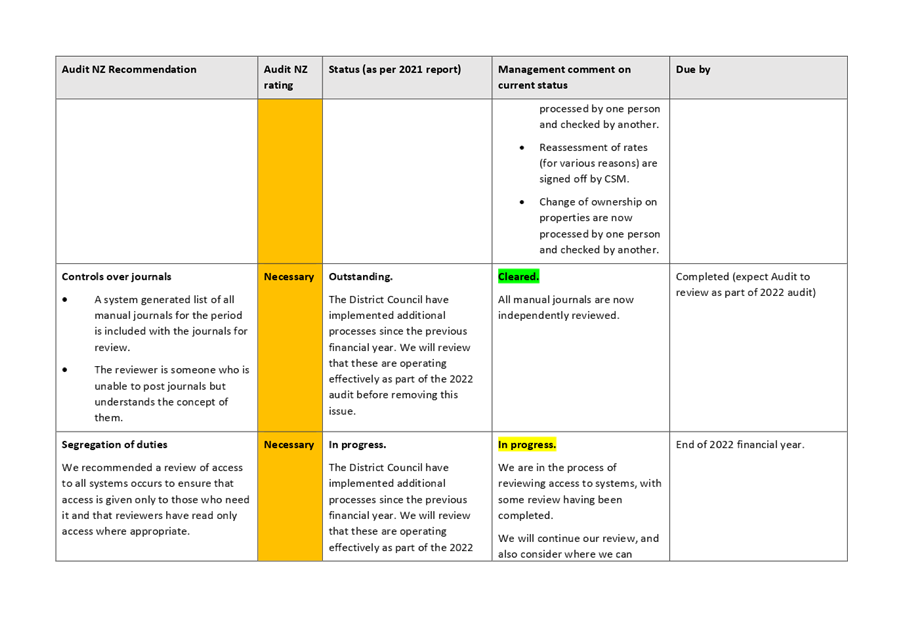
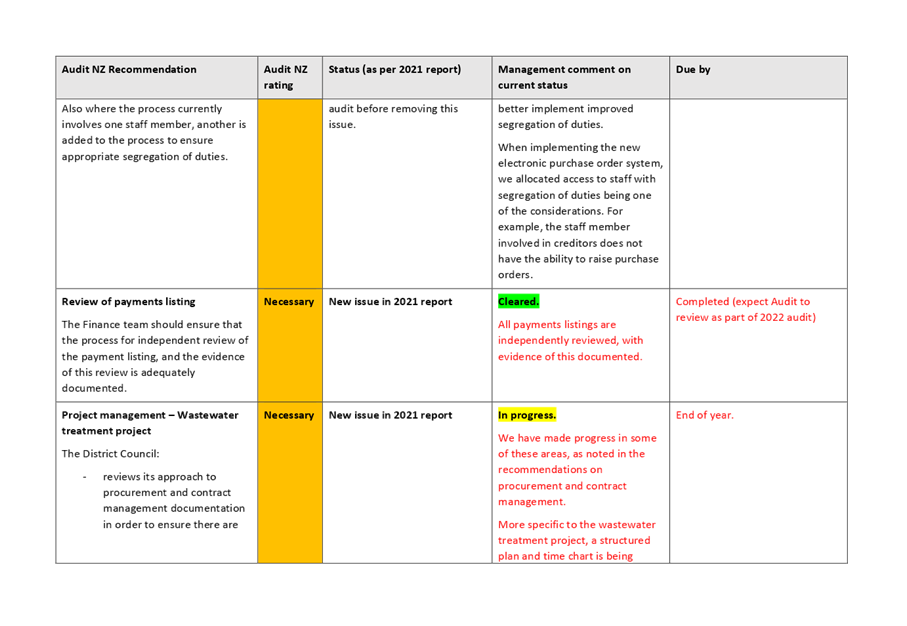





|
Audit
and Risk Committee Meeting Agenda
|
19
May 2022
|

6.4 Treasury
Policy Review
1. Purpose
For the committee to
review the updated Treasury Policy and recommend adoption by the Policy and
Strategy Committee.
2. Significance
The
matters for decision in this report are not considered to be of significance
under the Significance and Engagement Policy.
3. Background
The
Treasury Policy objective is to ensure that investments and liabilities are
managed in a prudent, effective, and efficient manner, as well as ensuring that
all external borrowing, investments and incidental financial arrangements meet
the requirements of the Local Government Act 2002.
The
Treasury Policy sets the treasury operational risk framework, in which staff
manage funding, interest rate, liquidity and credit risks to achieve the lowest
possible net interest cost to Council. This covers all borrowing, and
investments. The policy was previously reviewed as part of the Long-Term Plan
2021-2031 which was adopted in June last year.
While
the policy is not due for review until the next Long-Term Plan in 2024, Council
has decided to complete an earlier review to further align with current market
operational practice, recognise the new interest rate environment, and
incorporate advice from Treasury advisors Price Waterhouse Cooper (PWC).
4. Discussion
The
Council’s recently engaged treasury advisors, PWC, have reviewed and
updated the Council’s policy. The draft policy is based on good practice
in the sector, and reflects discussions held with officers and elected members
on the operation of Council’s treasury function.
Key
changes to the Treasury Policy relate to:
· Borrowing Limits, updated to show Council limits and LGFA limits
· Debt Funding Risk, including specific limits
· Liquidity risk, including requirement to hold $2m cash
· Interest rate Risk, including specific parameters/limits
· A section on LGFA, including that Council is a guarantor
· Investment mix updated to include externally managed funds and loans
and advances to community organisations.
· Section included on Counterparty Credit Risk including limits.
· Sections added to address Cash Management, Reporting and Policy
Review.
· Including Delegation of Authority and Approved Financial Instruments
as appendices.
The
full draft policy is included as attachment 1, with the current Treasury
Management Policy included as attachment 2.
5. Options
The
Committee is recommended to review the revisions to the treasury management
policy as summarised above and included in the updated policy (attachment 1)
and recommend adoption to the Policy and Strategy Committee.
The
Committee may recommend adoption of the policy subject to certain changes.
The
Committee may decide to not recommend adoption of the updated policy and
continue with the existing policy.
6. NEXT
STEPS
If
the Committee recommends the updated Treasury Policy for adoption by the Policy
and Strategy Committee who then adopt the policy, staff will then be able to
implement the recommended changes.
There
will be a transition period after the Council adopts the new policy, as some
new limits have been included in the policy, and Council may not be in
compliance with all of the new limits. Officers will work with PWC to ensure
that Council moves to a position of full compliance in a prudent way.
Compliance with policy will be reported at each Audit and Risk Committee
meeting.
7. CONSIDERATIONS
7.1 Climate change
No
specific considerations.
7.2 Tāngata whenua
No
specific considerations.
7.3 Financial impact
The
Treasury Management Policy sets the risk framework to manage net debt to
achieve the lowest possible net interest costs.
7.4 Community Engagement
requirements
No
specific community engagement required.
7.5 Risks
The
Local Government Act 2002 requires Council to have Liability Management and
Investment policies. The Treasury Management Policy covers both liability
management and investments, which include all external borrowing, financial
investment and incidental financial arrangements.
8. Recommendation
That the Committee:
1. Receives
the report.
2. Recommends
the Policy and Strategy Committee adopts the updated Treasury Management
Policy in attachment 1.
File
Number: 141409
Author: Kelly
Vatselias, Corporate Services Manager
Attachments: 1. Draft
CDC Treasury Management Policy ⇩
2. Current
Treasury Management Policy ⇩
|
Audit
and Risk Committee Meeting Agenda
|
19
May 2022
|



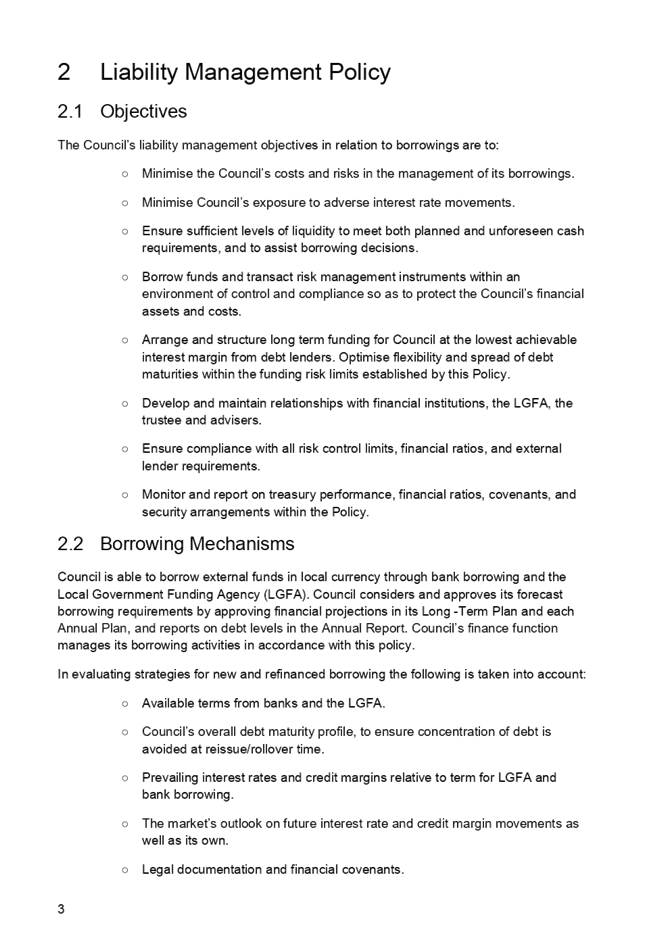
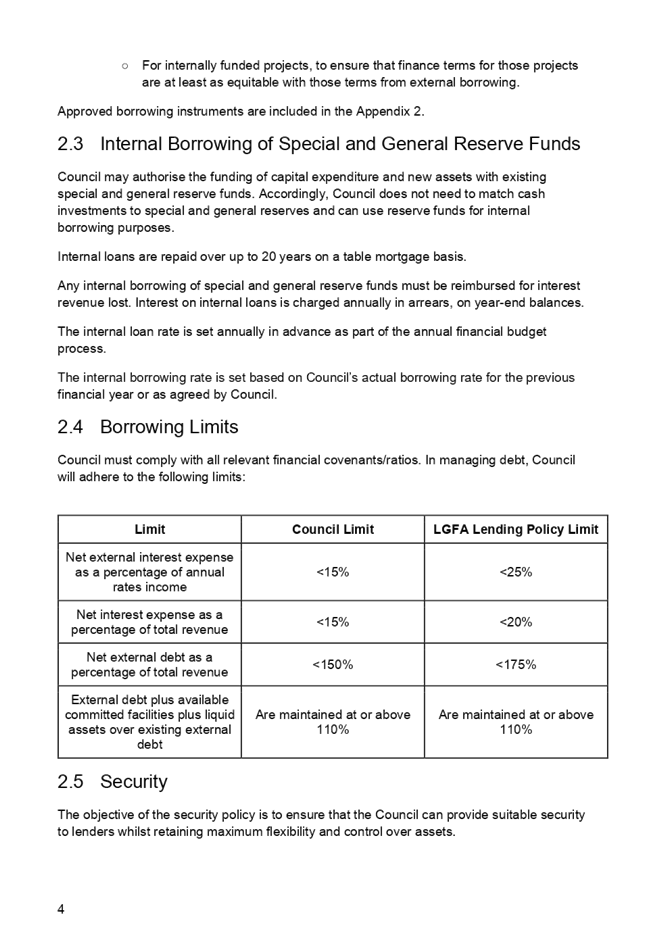
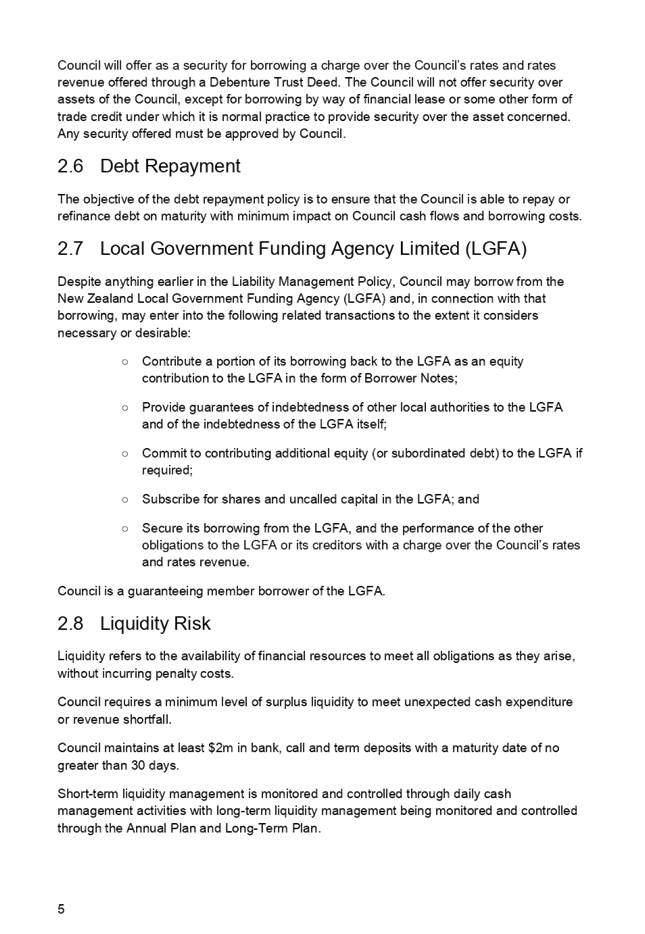
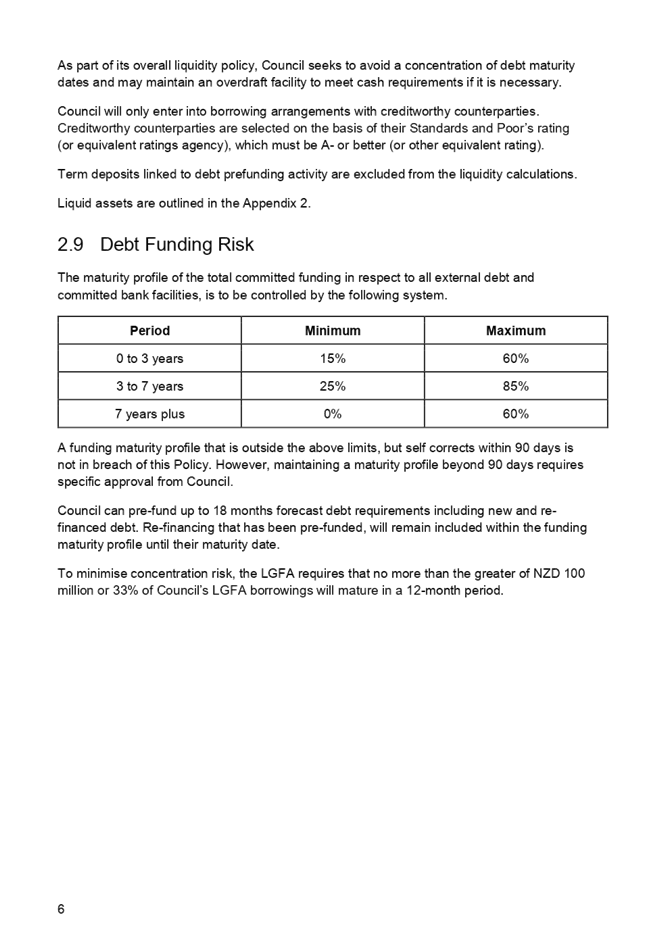
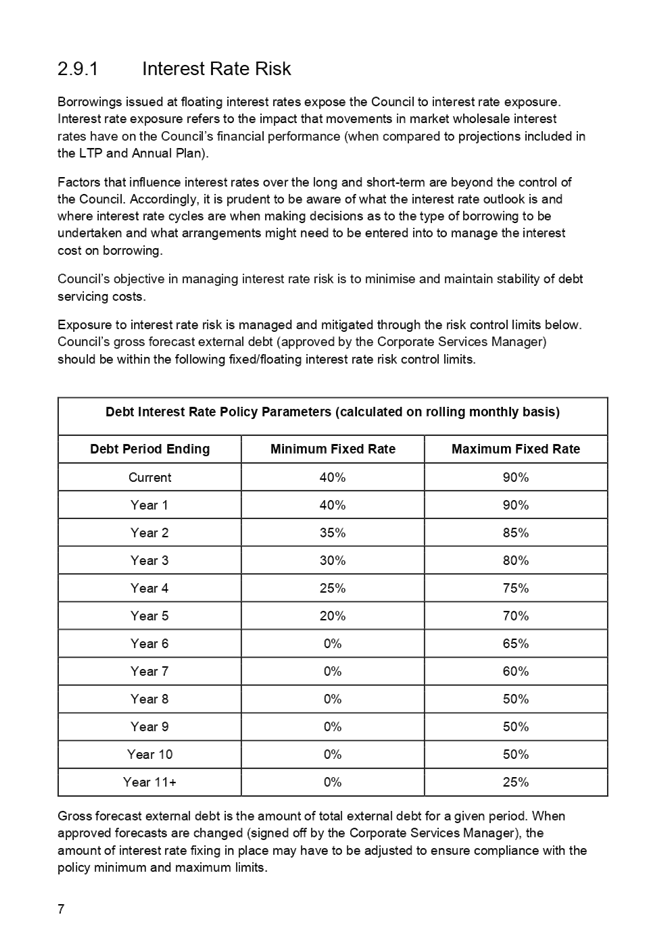
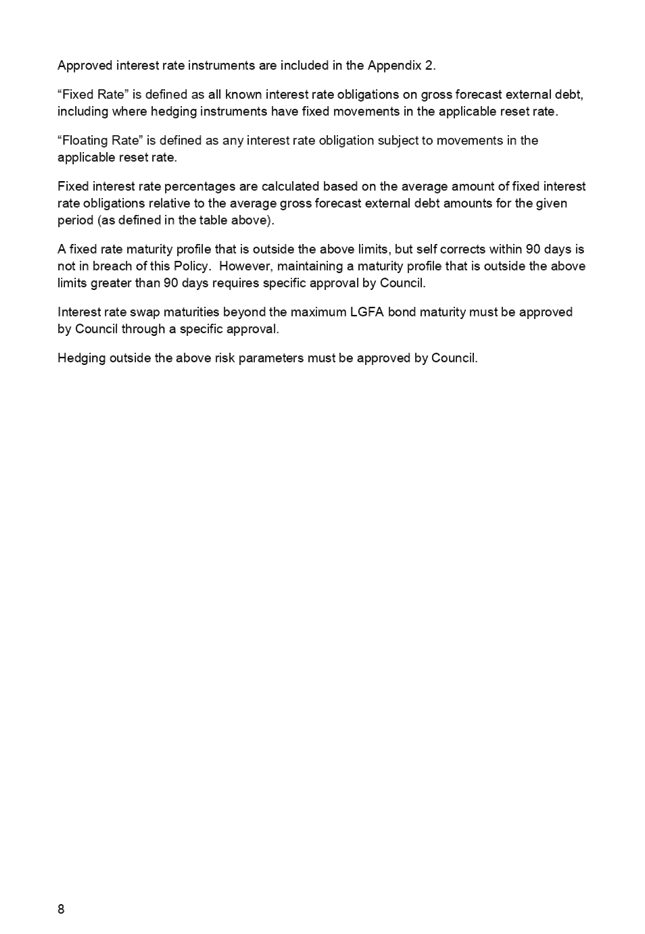
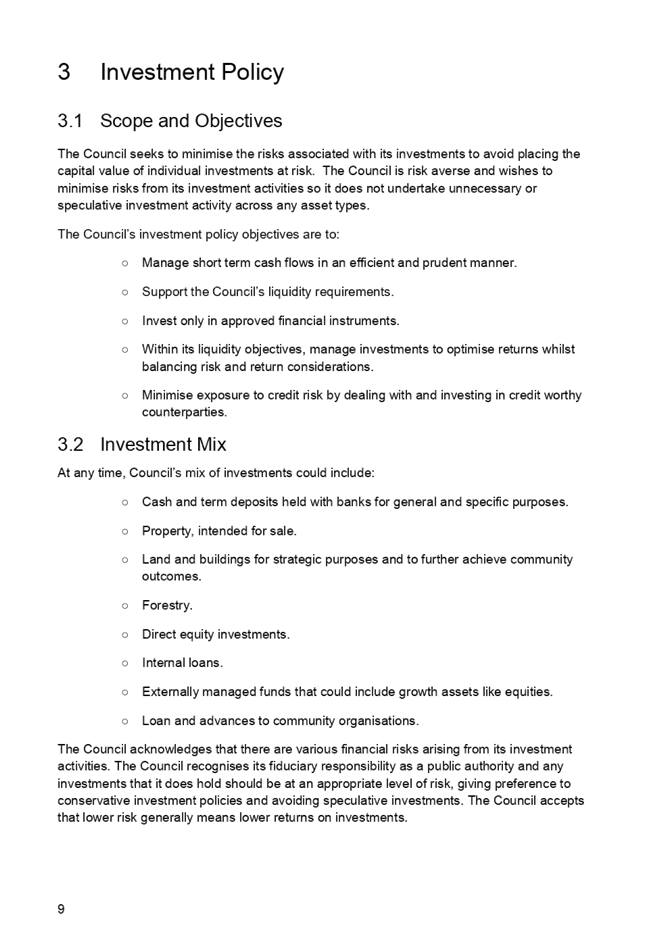
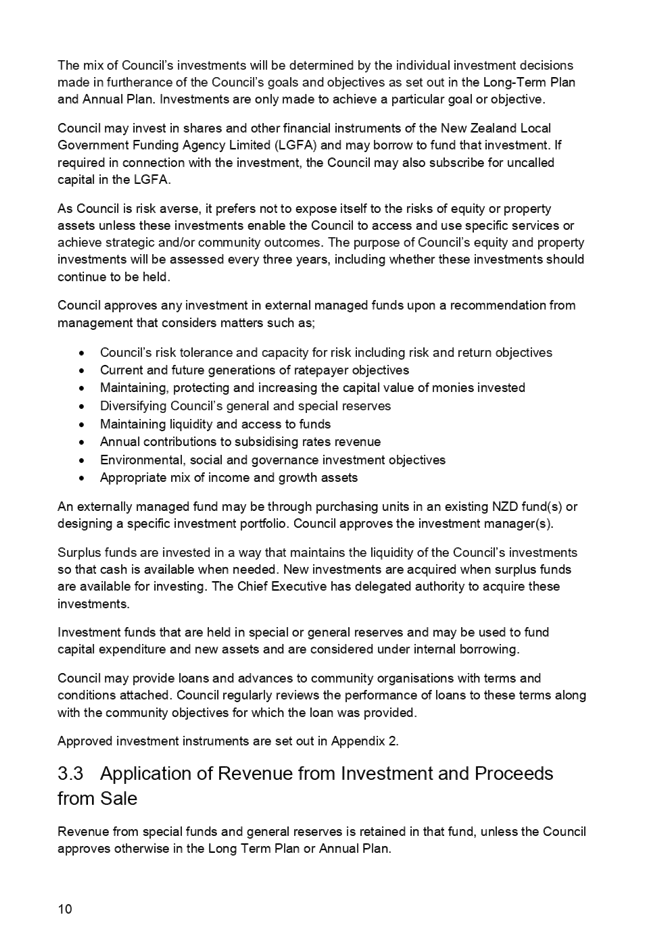
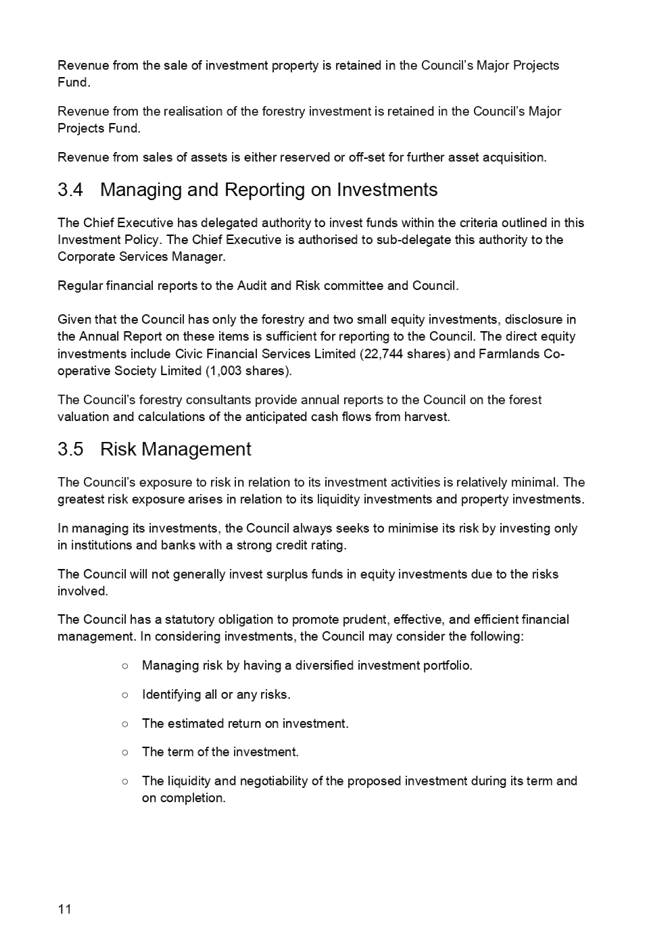
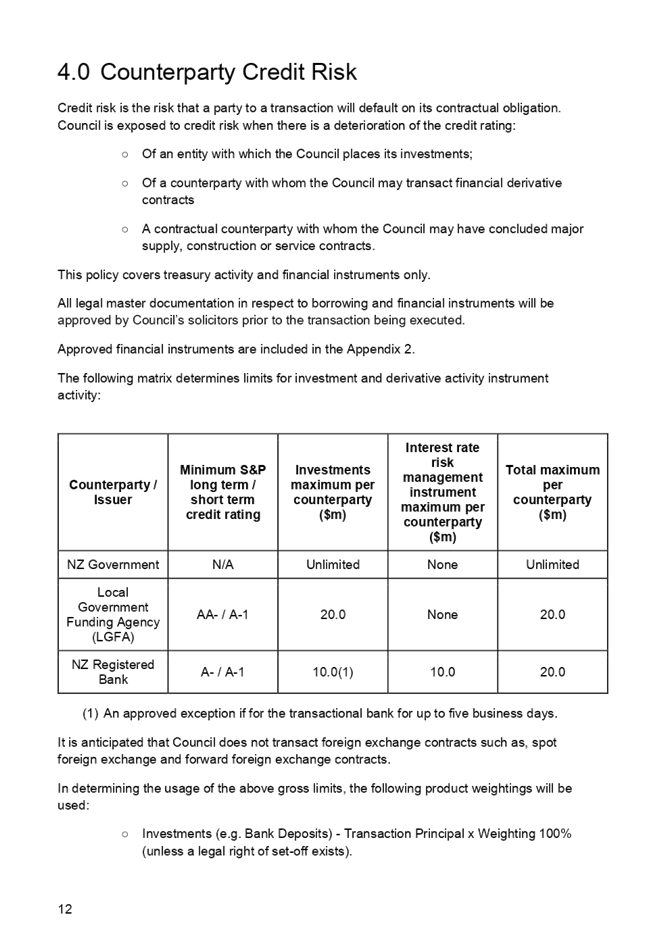

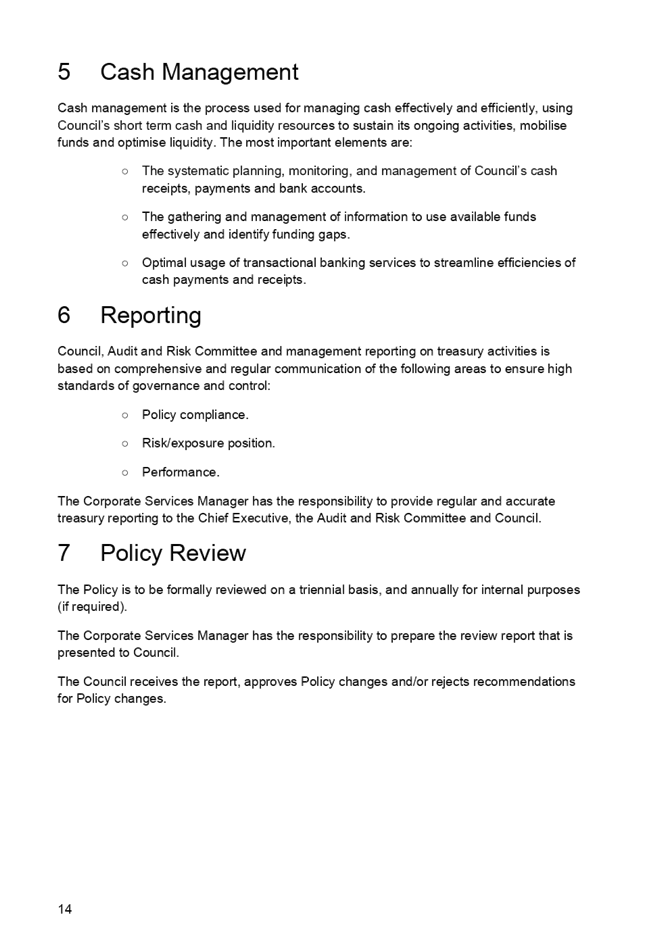

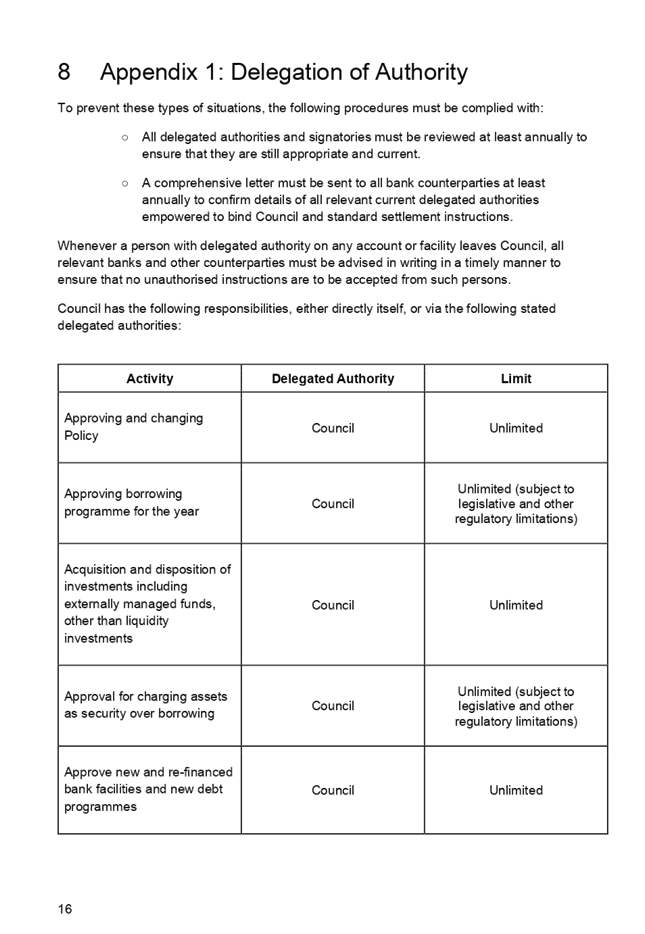
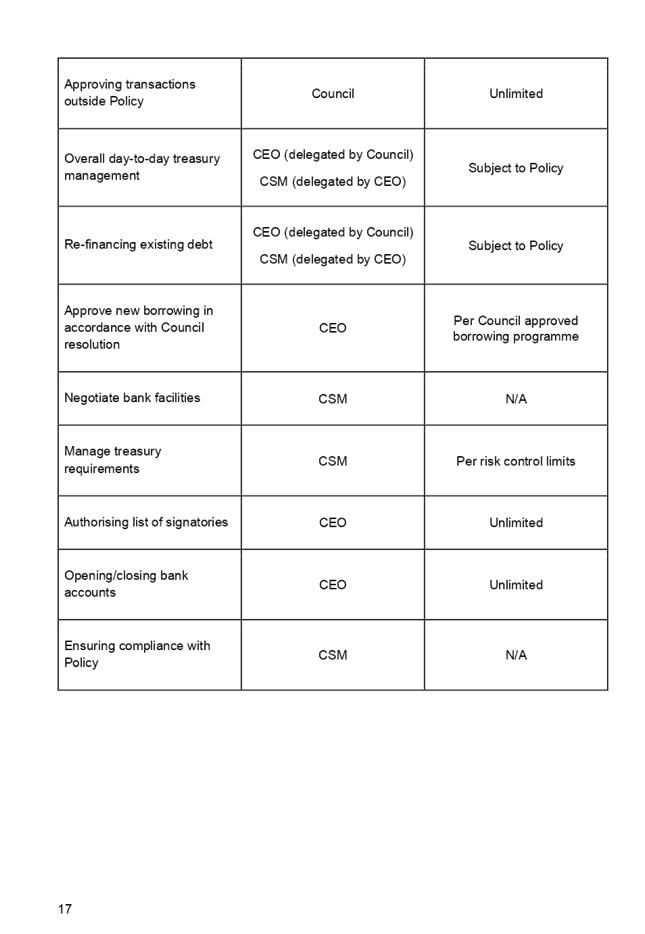
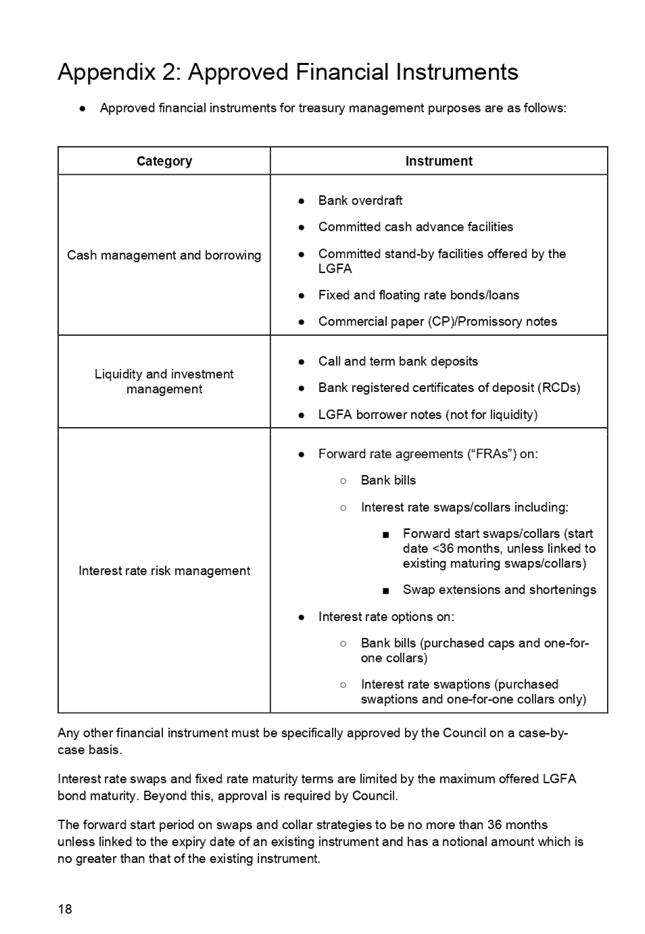

|
Audit
and Risk Committee Meeting Agenda
|
19
May 2022
|
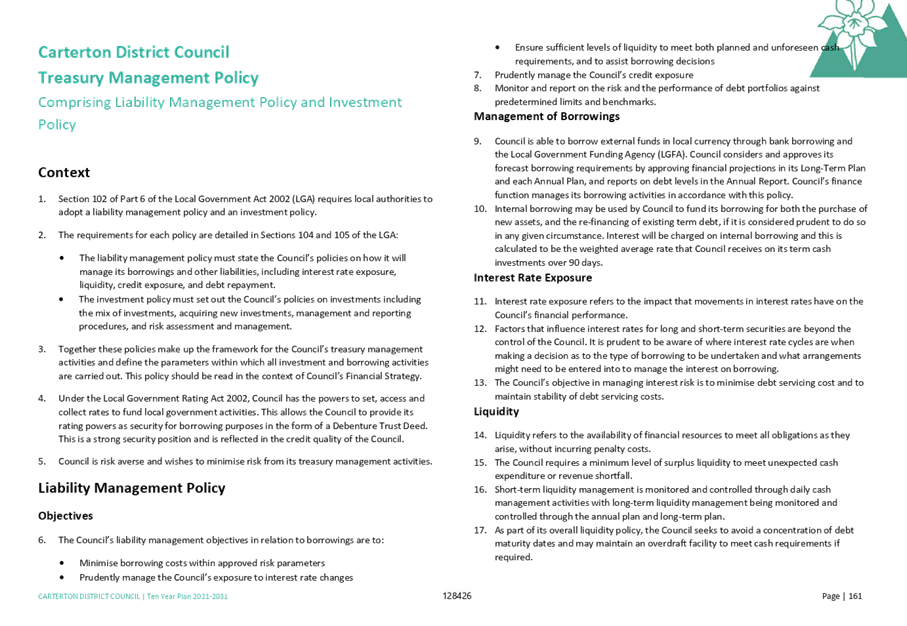
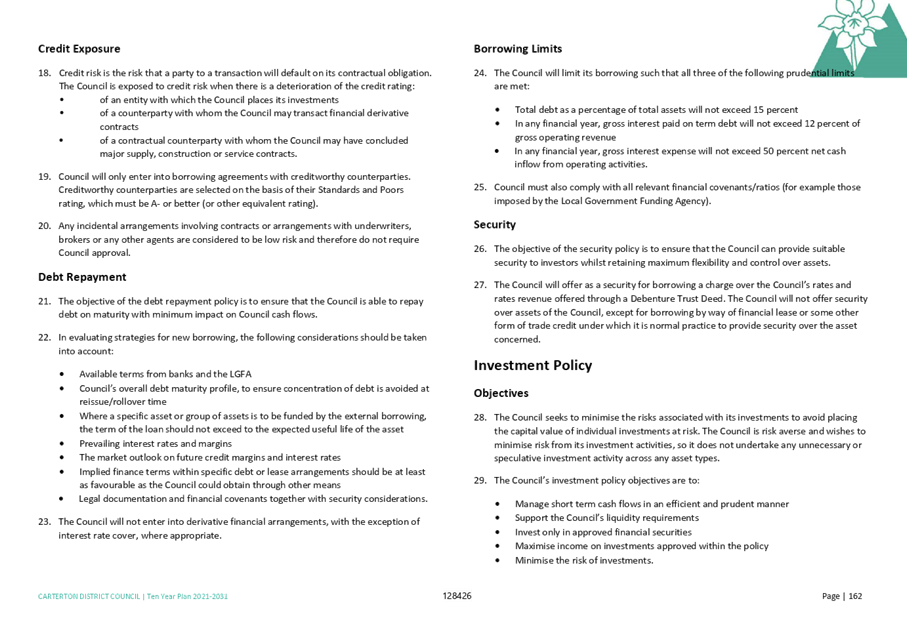
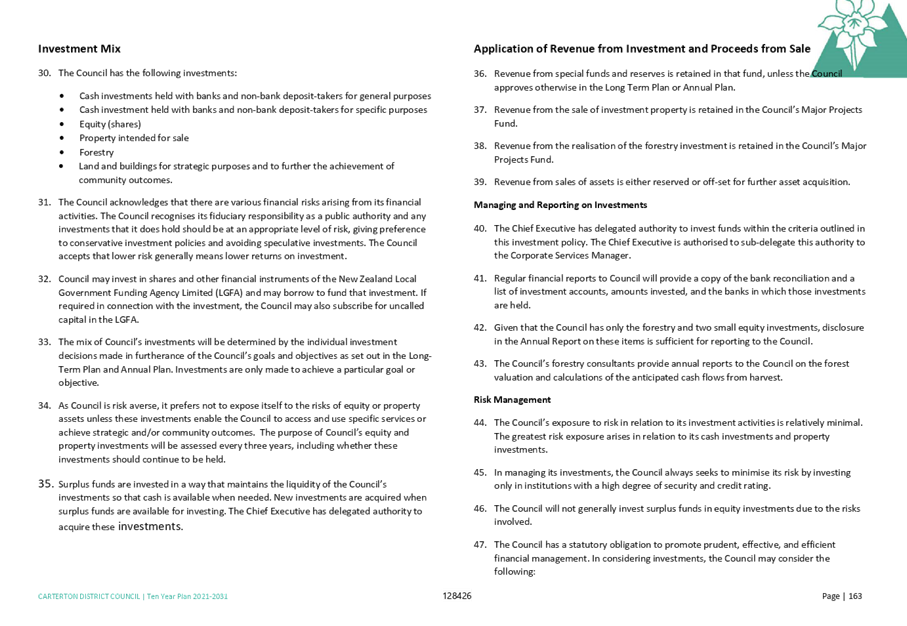

|
Audit
and Risk Committee Meeting Agenda
|
19
May 2022
|

6.5 Treasury
Update Report
1. Purpose
The purpose of the
report is to provide the Committee with an update on Council’s current
Treasury position.
2. Significance
The
matters for decision in this report are not considered to be of significance
under the Significance and Engagement Policy.
3. Background
This
report is an update as at 30 April 2022 on the current position of the
loan/debt status, and compliance against the parameters outlined in the
Council’s Liability Management Policy. An update on the position of
investments is also included.
4. Discussion
Historically
CDC has had a relatively low level of debt. Debt has been funded through BNZ,
with some internal loans when prudent. Reporting against debt has generally
been through financial updates to Council, and in the annual report.
As
CDC’s debt increases, the level of risk also increases, and as such we
plan to report on CDC’s treasury position and management at each Audit
and Risk Committee meeting. This covers the current debt position, forecast
debt position, compliance with policy and covenants, and risks.
At
the October 2021 Council meeting, the Council made the decision to become a
guarantor of the Local Government Funding Agency (LGFA). This will allow us to
have a further discounted interest rate on new or refinanced borrowing and will
also allow us to go over LGFA’s $20m limit on non-guarantor borrowers,
if/when required. On 27 April 2022, legal documentation was finalised and
Council is now a guarantor of LGFA.
This
report incorporates analysis undertaken by PwC, who have been engaged since
February to advise on Council’s treasury management. They have also
reviewed the current treasury management policy and have provided a revised
draft for consideration. This draft is presented separately in another
report to the Committee.
5. CURRENT
DEBT POSITION
Since
the Treasury Update Report was presented at the February Audit and Risk
Committee meeting, the council have not borrowed any additional funds other
than to refinance short-term borrowings with a floating rate note with LGFA for
$2 million.
The
total capital programme for the 2021/22 year is approximately $14m. The amount
borrowed through LGFA pre-funds our loan-funded capital programme for the rest
of the financial year (excluding a short-term bond which ended April 2022 and
was refinanced). By pre-funding our borrowing for the rest of the year, we have
taken advantage of LGFA’s still low interest rates.
We
continue to have internal borrowings of approximately $6m, which as previously
discussed, can be a prudent way to manage debt. However, it is not always
visible in financial reporting, as only external debt is shown in the Statement
of Financial Position. For the 2021 annual report, we included in our
borrowings note disclosure, a table to show our internal debt.
Position as at 30 April 2022:
|
LGFA
|
$14,700,000
|
|
Internal borrowings
|
$6,100,000
|
|
TOTAL
|
$22,800,000
|
The
average interest rate on our borrowings with LGFA has risen to $2.01% from
1.72% after refinancing of short-term funding.
As
noted in the previous report, interest rates have responded to economic
conditions arising from the pandemic and global supply issues. Council is in a
good position with a still low average interest rate, and the capex programme
for the remainder of the year pre-funded. The internal borrowings have also
meant a decrease in external interest expense, as our external borrowing is not
as high as budgeted, due to the use of internal borrowing.
The
current interest rate has been achieved through borrowing from a number of
different bonds, ranging from 6 months to eight years. In selecting the bonds,
we considered interest rates, the timing of bonds, and the three waters reform
(loans for three waters activities are in bonds with dates before July 2024).
The following graph identifies the anticipated level of borrowing under the 10
Year Plan (black line) and the desirable proportion of that borrowing at fixed
rates (red line). The grey line shows a minimum level of borrowing at fixed
rates. In effect the graph reflects a desirable balance between fixed and
floating rates.
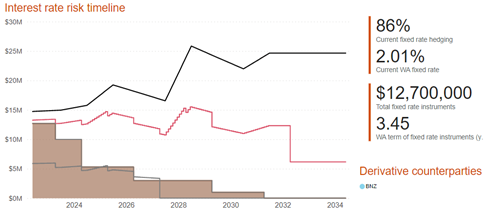
6. LIABILITY
MANAGEMENT COMPLIANCE
Council
adopted Liability Management and Investment Policies as part of the 2021-31
Long-Term Plan. The new Policies were effective as of the date of adoption.
The
Liability Management Policy stipulates a number of parameters relating to the
prudent management of debt. For the purposes of this report, the key policies
are each addressed separately, as relevant.
6.1 Interest rate exposure
Interest rate exposure refers to the impact that movements in
interest rates have on the Council’s financial performance.
Council’s objective in managing interest risk is to minimise debt
servicing cost and to maintain stability of debt servicing costs.
Factors
that influence interest rates for long and short-term securities are beyond the
control of the Council. It is prudent to be aware of where interest rate cycles
are when making a decision as to the type of borrowing to be undertaken and
what arrangements might need to be entered into to manage the interest on
borrowing.
We
have considered our interest rate exposure when drawing down borrowings and
have structured our borrowings across bonds that end at different dates.
Interest
rates are continuing to increase, and we will continue to monitor interest
rates and consider ways to manage our interest expense. This includes the
pre-funding of year 1 capital programme.
6.2 Liquidity
Liquidity
refers to the availability of financial resources to meet all obligations as
they arise, without incurring penalty costs. The policy states that Council
requires a minimum level of surplus liquidity to meet unexpected cash
expenditure or revenue shortfall. The policy does not specify the level of
liquidity required.
On 31
March 2022 our liquidity ratio was 3.5, where our current liabilities are $4.9
million and liquid assets are $17.4 million.
6.3 Credit exposure
Credit
risk is the risk that a party to a transaction will default on its contractual
obligation. Policy states the Council will only enter into borrowing agreements
with creditworthy counterparties (rated A- or better).
LGFA
is currently rated AAA by S&P Global Ratings.
6.4 Borrowing limits
The policy specifies the following borrowing
limits:
|
Policy
|
Current
position (as at 31 March 2022)
|
|
Total debt as a percentage of total assets
will not exceed 15 percent.
|
5.7%
|
|
In any financial year, gross interest paid
on term debt will not exceed 12 percent of gross operating revenue.
|
1.5%
|
|
In any financial year, gross interest
expense will not exceed 50 percent net cash inflow from operating activities.
|
3.7%
|
7. forecast
position
We
are currently in year 1 of the Long-Term Plan. Capital expenditure is forecast
for the year, of which a large portion is loan funded, resulting in forecast
debt of $18m at 30 June 2022. This is well within our limits, as shown in the
LTP prudence benchmark graphs. We have pre-funded all loan-funded capital works
forecast in year 1 to take advantage of low interest rates.
Currently
we are still holding internal debt and will continue to assess whether it is
more prudent to continue to hold this internally, or transfer to external debt
through the LGFA.
8. Investments
Current
investments held are as follows:

Currently
the higher than normal cash levels reflect the receipt of maturing short-term
investments relating to special reserve investments and pre-funding for this
year’s capital programme. We intend to place short-term deposits
across at least two different banks and are currently in discussions on
rates.
Special
reserve investments are funds set aside for specific purposes, such as
infrastructure contributions.
The
average interest rate on term investments is currently approximately 1%.
9. NEXT
STEPS
Staff
will continue to monitor and report on treasury position and compliance to the
Audit and Risk Committee.
10. CONSIDERATIONS
10.1 Climate change
There are no specific climate change considerations.
10.2 Tāngata whenua
There are no specific tāngata whenua considerations.
10.3 Financial impact
There
are no financial impacts resulting from the decisions in this report.
10.4 Community Engagement requirements
There are no community engagement requirements.
10.5 Risks
Key
risks relate to treasury management areas outlined above. As demonstrated, we
are in compliance with policy, and have significant headroom in terms of our
borrowing capacity.
As
borrowings increase, risk becomes higher. For example, changes in interest
rates can have a significant impact. In order to reduce risk, we can, and
will, consider the following:
· Interest rate exposure
· Policy limits
· Implications of the potential 3 waters reform
We
have already engaged PwC as an external advisor as previously agreed, which
will help us to further manage risks.
11. Recommendation
That the Committee:
1. Receives
the report.
2. Notes
the current Treasury position and compliance with policy.
File
Number: 138850
Author: Kelly
Vatselias, Corporate Services Manager
Attachments: Nil
|
Audit
and Risk Committee Meeting Agenda
|
19
May 2022
|

6.6 Insurance
update
1. Purpose
To provide an annual update to the Committee
regarding the Council’s insurance policies and an update on the insurance
environment.
2. Significance
The
matters for decision in this report are not considered to be of significance
under the Significance and Engagement Policy.
3. Background
Currently
Council purchases insurance to cover the risks associated with:
· Material damage to buildings and above ground plant, including
construction of new or renovation, excluding larger projects.
· Material damage to our 3 Waters underground infrastructure.
· Loss of forest income based on its current value as a crop.
· Loss of material, cash or capability through crime or nefarious act
(e.g., fraud).
· Usage of our motor vehicle and mobile plant fleet.
· Legal and associated costs related to liability claims arising from
statutory, public and professional instances of Council behaviour or action.
· Well-being of staff and elected members through trauma and accident
insurance.
· Community usage of our facilities.
The
exception to this range of cover is roading; no structural assets such as
bridges nor the roading network are covered for material damage. Given
the shared cost of maintaining and extending/improving the network with Waka
Kotahi, the risk of damage through adverse events is carried in part by the
funding mechanisms available to Waka Kotahi and to a lesser extent by Council
through the annual programme and a special reserve fund for that purpose.
The
cost of insurance cover has risen over time, and significantly last year, with
premiums as follows:
|
2019/20
|
2020/21
|
2021/22
|
2022/23 draft budget
|
|
$221,000
|
$228,000
(3.2% increase)
|
$278,000
(21.9% increase)
|
$318,000 TBC
(14.4% increase)
|
Additionally,
this year Council has purchased a specific construction policy to cover the
remedial works at the WWTP, costing $26,000.
4. Discussion
The
increase of our insurance cover by nearly 50% in three years is driven by two
factors:
· The rise of construction costs necessary to remedy material damage.
· Insurer reluctance to provide cover given a claim history or the
lack of profit within the general local government sector. In this
respect, it is the perception of the international re-insurers that determines
the willingness to accept the insurance risk.
General
market perception about local government is not favourable, particularly in
respect of the liability products, largely driven by claim history and
perceived risk impacts to insurers. This relates to the risks associated
with building and similar consents provided to the construction industry.
Council’s
capability to sustain this upward trend motivates its need to consider the
nature and extent of cover we purchase, its variation or an alternative way to
manage the risk.
The
driver to take out insurance is the realisation that if the risked event
occurs, it will generally do so when Council is least able to manage the
remedial cost (e.g. fire or extreme adverse weather), or that it enables an
opportunity cost (continue normal activities otherwise not undertaken due to
the impact of the event – e.g. motor vehicles).
5. Options
The
other option to purchasing insurance is to self-insure. That is, build
financial capacity to cover the risks Council would otherwise purchase to
cover. This can be done in a variety of ways:
· Increase the excess levels to reduce premium – this can have a
positive effect where insurers perceive favourable profit. This is done
by adjusting operational budgets.
· Assume the risk and manage the impacts through appropriate capital
provision. We currently do this for mechanical damage – essentially
our reticulation pumping – where our neighbours insure. Or we
adjust operational budgets to cover instances (e.g. our motor vehicle and
mobile plant fleet), but doing so where respective outgoings are positive over
a period (three to five years).
· Assume the risk and deal with impacts after the event.
· Do nothing – continue to purchase insurance as risk is
unsustainable.
6. NEXT
STEPS
Council
is currently considering the insurance programme for 2022/23, working with
Marsh (our broker for general insurance) and Civic Financial Services (LAPP)
relating to our 3 Waters underground facilities.
Our
approach currently is to continue the status quo but test any movement in
excess in order to achieve a decreased premium, at an acceptable risk level.
7. CONSIDERATIONS
7.1 Climate change
Insurers
are also focusing on climate change and its impact on risk profiles. We are
seeing insurers looking very closely at regions and areas susceptible to flood
or sea inundation. However, there are no climate change considerations relating
to the decisions in the report.
7.2 Tāngata whenua
There
are no specific tāngata whenua considerations relating to the decisions in
this report.
7.3 Financial impact
Financial
impacts on council are discussed in this report, noting that insurance premiums
are increasing annually. Insurance costs are included within our annual plan
and 10-year Plan budgets. There are no financial impacts relating to the
decisions in this report.
7.4 Community Engagement
requirements
There
are no community engagement requirements.
7.5 Risks
There
are no additional risks not already covered in the report.
8. Recommendation
That the Committee:
1. Receives
the report.
File
Number: 141347
Author: Kelly
Vatselias, Corporate Services Manager
Attachments: Nil
|
Audit
and Risk Committee Meeting Agenda
|
19
May 2022
|

6.7 Government
Reform Update
1. Purpose
For the Committee to
receive an update on Central Government’s reform changes impacting upon
Local Government.
2. Significance
The
matters for decision in this report are not considered to be of significance
under the Significance and Engagement Policy.
3. Background
There
are a number of significant pieces of work being completed by Central
Government which impacts Local Government.
This
report is a standard report to the Audit and Risk Committee which outlines any
key changes in government reform since the previous update report to the
Committee.
4. Changes to Drinking water standards
4.1 Overview
Taumata
Arowai took over from the Ministry of Health as the drinking water regulator on
15 November 2021.
4.2 Changes since the last
update report
At the
end of March consultation closed on proposed new Drinking Water Standards,
Quality Assurance Rules, Aesthetic Values, Acceptable Solutions for Roof Water
Supplies, Spring and Bore Water Supplies and Rural Agricultural Water Supplies,
and Network Environmental Performance Measures. Feedback will be used to further refine the proposed
standards/documents which set the regulatory approach before these are
finalised and implemented later in 2022.
In
early April Taumata Arowai launched the Public Register of Drinking Water
Supplies. The register allows consumers to be able to
find out more about where their drinking water comes from. https://hinekorako.taumataarowai.govt.nz/publicregister/supplies/
5. Three waters review Update
5.1 Overview
The
Government’s Three Waters Reform proposals are a comprehensive change to
the way fresh water, wastewater and storm waters are managed for our
communities.
The
reforms shift the current 67 council-owned and operated three waters services
into four new publicly owned entities to manage the future delivery of these
services from July 2024.
Papers
have gone to previous Audit and Risk Committee and Ordinary Council meetings,
which outline the reform in more detail.
5.2 Changes since the last
update report
The
Local Government Minister shared the latest Three Waters Reform update on
Friday 29th April 2022. They advised that Three Waters reforms will
go ahead with local councils taking non-financial shareholdings in four new
public water entities. The proposed co-governance of regional groups which will
appoint the new entities’ governance boards and provide public
accountability for the entities is set to remain.
Cabinet
agreed to the bulk of 47 Representation, Governance and Accountability
working group recommendations (see link to summary table of working group recommendations and government
response).
The
Water Services Entities Bill is expected to be introduced to the House in
mid-2022. People can make submissions on the Bill when it is referred to the
Select Committee shortly after. (see link to the DRAFT Water Services Entities Bill).
A more
detailed update report is part of the agenda going to the Ordinary Council
meeting on 25 May.
6. Resource Management ACT
6.1 Overview
The
Government is repealing the Resource Management Act 1991 (RMA) and replacing it
with new legislation.
· The Natural and Built Environments Act (NBA) will be the main
replacement for the RMA;
· The Strategic Planning Act (SPA) will require councils,
iwi/Māori and central government agencies to develop 30-year regional
spatial plans; and
· The Climate Change Adaptation Act (CAA) deals with the legal
and technical matters associated with climate change adaptation and managed
retreat.
Once
the select committee has considered submissions, it will report its
findings to Parliament. Any changes will be made before the full Bill
is formally introduced.
6.2 Changes since the last
update report
There
have been no changes since the February report.
7. Emergency Management Bill
7.1 Overview
In
December 2021, the Minister for Emergency Management announced that a new
Emergency Management Bill will be introduced to replace the Civil Defence and
Emergency Management Act 2002.
The
Civil Defence Emergency Management (CDEM) Amendment Bill arose from a review of
the legislative framework for recovery. There are two stages to the review:
· Stage One: focussed on small to moderate-scale emergencies (which
are the most frequent experienced in New Zealand; for example, from floods and
weather-related event) and enhancing the recovery provisions in the Civil
Defence Emergency Management Act 2002; and
· Stage Two: focussed on large-scale emergencies (i.e., like the 22
February 2011 earthquake) and what legislation might be needed for recovery.
Stage Two has not yet commenced.
The
CDEM Amendment Bill seeks to provide a smooth and coordinated transition of
arrangements and powers from the response phase to the recovery phase. The
proposed amendments have regard to the constitutional conventions that need to
accompany any legislation that provides powers in emergency-like situations.
7.2 Changes since the last
update report
The
Wellington CEDM Group undertook a joint submission on the Modernising
the Emergency Management Framework document that was distributed by NEMA on 14
January 2022. The groups feedback focused on five main areas, these are
summarised below:
· That
there needs to be more thought given to a number of the proposals to help
respondents understand ‘what’ (exactly) is being proposed in each
of the options that are being presented.
· The
development of proposals should be undertaken in collaboration with CDEM Groups
and iwi/Māori to help understand their different perspectives and areas of
concern – especially in relation to ‘how’ decisions are going
to be implemented. After all, if selected options are poorly informed, poorly
crafted or misunderstood by those who then have to implement them, then they
are unlikely to be delivered in the way they were intended and are unlikely to
achieve their desired outcomes.
· The
CDEM groups have repeatedly been told in both written and verbal form that
resourcing is ‘not in scope’ for this particular piece of work. As
the above listed responses show, given current local government funding
pressures, the ability of NEMA and CDEM Groups to deliver on what is proposed
is going to take additional resources – resources that are not currently
budgeted or able to be funded by CDEM Groups. This being the case, we think any
final statement of support for the proposed changes will be dependent on there
being full transparency on where the additional funding is going to come from
and when it is going to be available.
Concerns
about the timeframes that have been identified for this legislative change.
Rather than rush things though and end up with something that is not
fit-for-purpose, we strongly recommend that the Minister and NEMA slow the
process down to ‘do it once, do it right’ and get a systematic
review that aligns with the opportunities presented by the 3 Waters review, RMA
reforms (which are critical to Reduction) and the pending reforms in Local
Government.
8. Local Government Review
8.1 Overview
As a
result of the cumulative changes being progressed as part of the
Government’s reform agenda, the overall purpose of the Review is to
identify how our system of local democracy and governance needs to evolve over
the next 30 years, to improve the wellbeing of New Zealand communities and the
environment, and actively embody the Treaty partnership.
The
Review’s initial focus will be on how local government will be a key
contributor to the wellbeing and prosperity of New Zealand and an essential
connection to communities in the governance of New Zealand in the future.
This
will enable scoping of the broader work to follow. The Review will then focus
on answering the priority questions identified during its initial scoping work.
On 30
September 2021 an interim report presented to the Minister signalled the
probable direction of the review and key next steps.
8.2 Changes since the last
update report
No
changes since the February update report. On 30 September 2022 a draft report
and recommendations will be issued for public consultation.
9. CONSIDERATIONS
9.1 Climate change
Responses
to the emergency management bill proposal included considerations in climate
change emergencies such as flooding and severe drought becoming more frequent.
9.2 Tāngata whenua
Responses
to the emergency management bill proposal included suggestions that Māori
have a greater input in option development.
9.3 Financial impact
Feedback
to the emergency management bill specifically incorporated the inadequate
provision of funding for some proposed additional shared responsibilities.
9.4 Community Engagement
requirements
All
the above proposed legislative changes are the responsibility for Central
Government to coordinate public responses.
9.5 Risks
Each
of the proposed legislative changes have a potential impact on the form and
function of local government.
10. Recommendation
That the Committee:
1. Receives
the report.
File
Number: 141348
Author: Kelly
Vatselias, Corporate Services Manager
Attachments: Nil
|
Audit
and Risk Committee Meeting Agenda
|
19
May 2022
|

6.8 Risk
Register Update
1. Purpose
To
advise the Audit and Risk Committee on changes to the Carterton District
Council Risk Register.
2. Significance
The
matters for decision in this report are not considered to be of significance
under the Significance and Engagement Policy.
3. RISK MANAGEMENT FRAMEWORK
Council’s Risk
Management Framework outlines Council’s risk appetite and informs the
ranking for the Risk Register (Attachment 1). The Register is
regularly reviewed and updated as required with the last update in February 2022. The Register contains 32 identified risk items
with an associated coloured risk score for each item, as per the approved Risk
Management Framework. The unmitigated score of each item is recorded in
the first column, with the second column showing the scores once mitigated.
4. Risk register changes
In
February 2022, the Committee endorsed the addition of a new risk item in
relation to climate change as outlined in Attachment 1.
At the
time of endorsement, further assessment was required to confirm the
associated risk score and mitigations. Officers suggested that the
unmitigated risk score fall in the extreme risk (red category) and the
mitigated score be at the significant risk (orange category) level.
The
Climate Change Advisor is currently working with elected members and officers
to confirm the risk scores as the part of Council’s Risk and Resilience
Strategy. An update on this work is provided under a separate report for
this meeting, with a further workshop to develop the mitigation measures
scheduled over the coming months. The final Strategy and the confirmed
Risk Register scores will be presented to the Committee on 18th
August 2022.
Overall, the total number and categorisation
of risks are as below (not including climate change).
|
Risk Score
(unmitigated)
|
Risk
Score (mitigated)
|
Level of
Risk
|
|
11
|
Zero
|
Extreme
risk
|
|
14
|
2
|
Significant
risk
|
|
5
|
14
|
Moderate
risk
|
|
Zero
|
15
|
Low
risk
|
5. CONSIDERATIONS
5.1 Climate change
None
for the Risk Register.
5.2 Tāngata whenua
None
for the Risk Register.
5.3 Financial impact
There
are no budgetary implications for the Risk Register.
5.4 Community Engagement
requirements
None
for the Risk Register.
5.5 Risks
None
outside of the specified risks in the Register.
6. Recommendation
That the Committee:
1. Receives
the report.
2. Notes
the proposed addition to the Risk Register in relation to climate change
will be presented at the next Committee meeting on 18 August 2022.
File
Number: 138851
Author: Geri
Brooking, People and Wellbeing Manager
Attachments: 1. CDC
Risk Register ⇩
|
Audit
and Risk Committee Meeting Agenda
|
19
May 2022
|
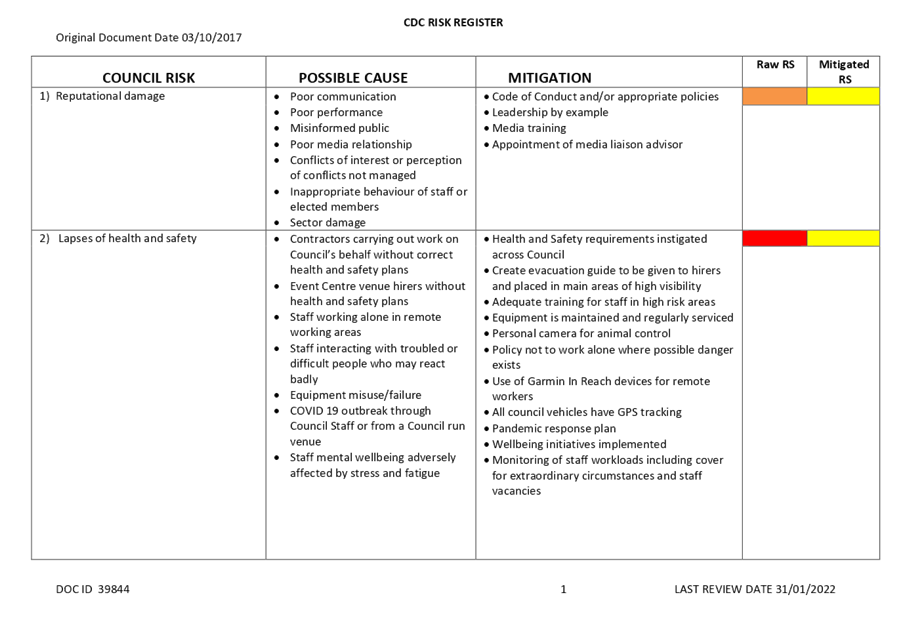
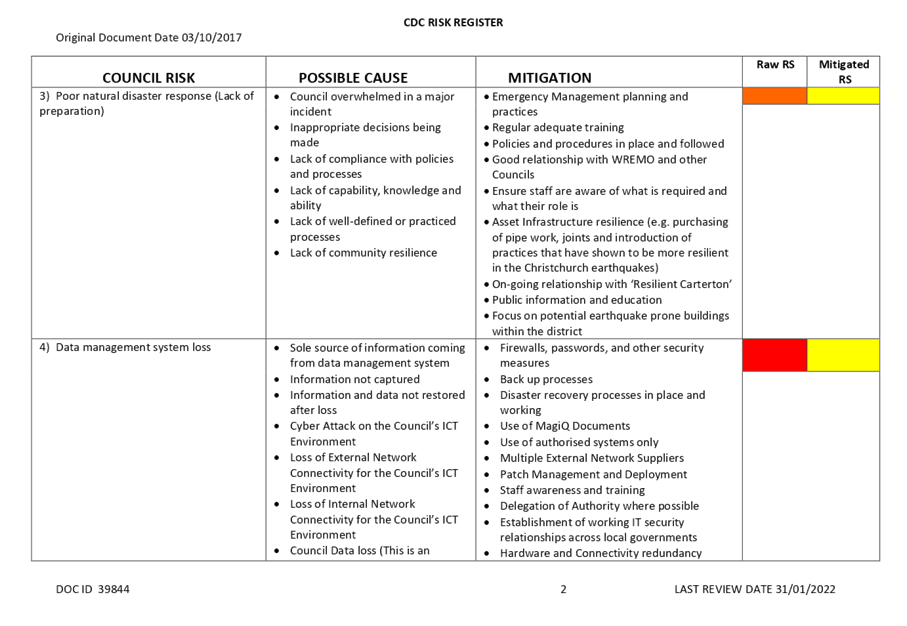
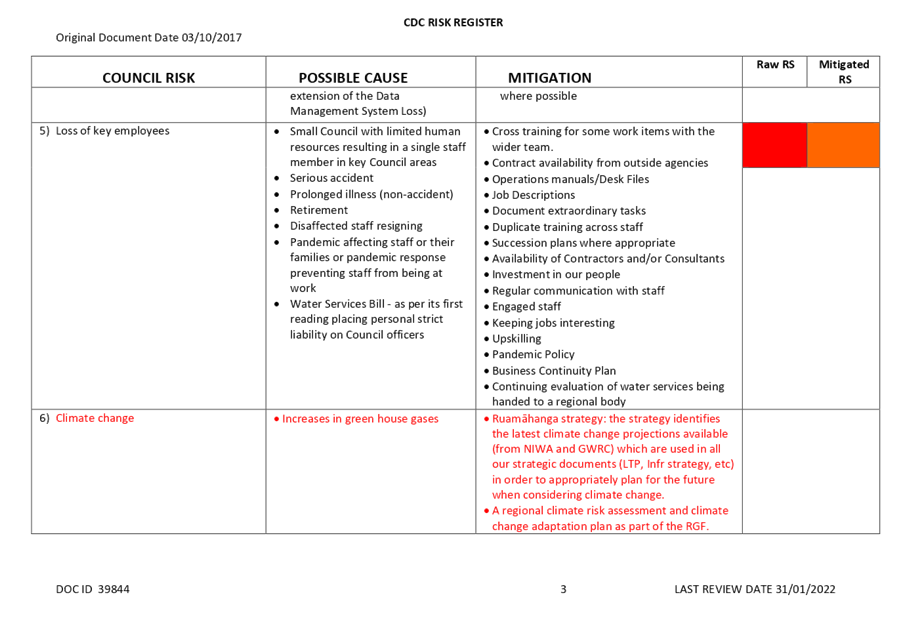
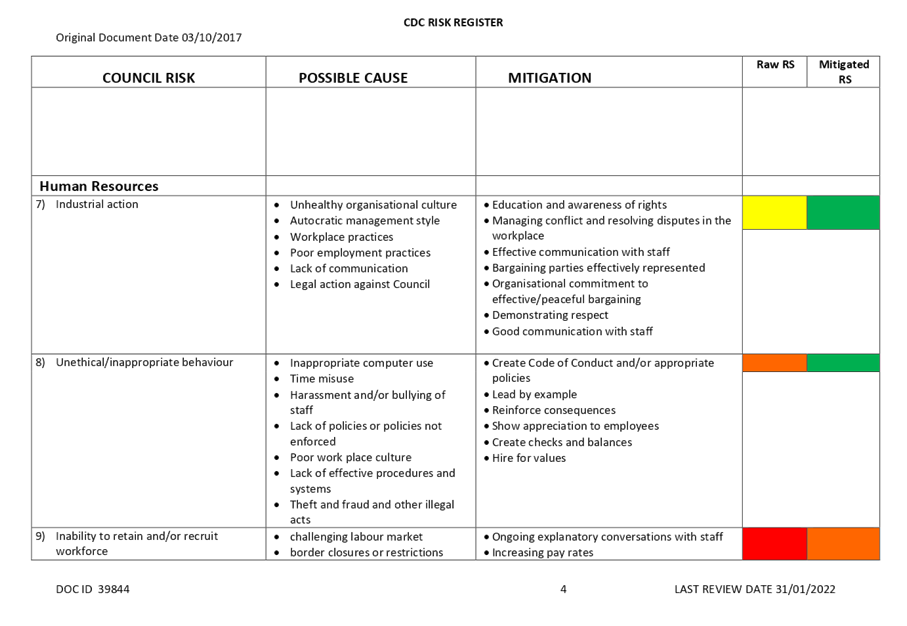
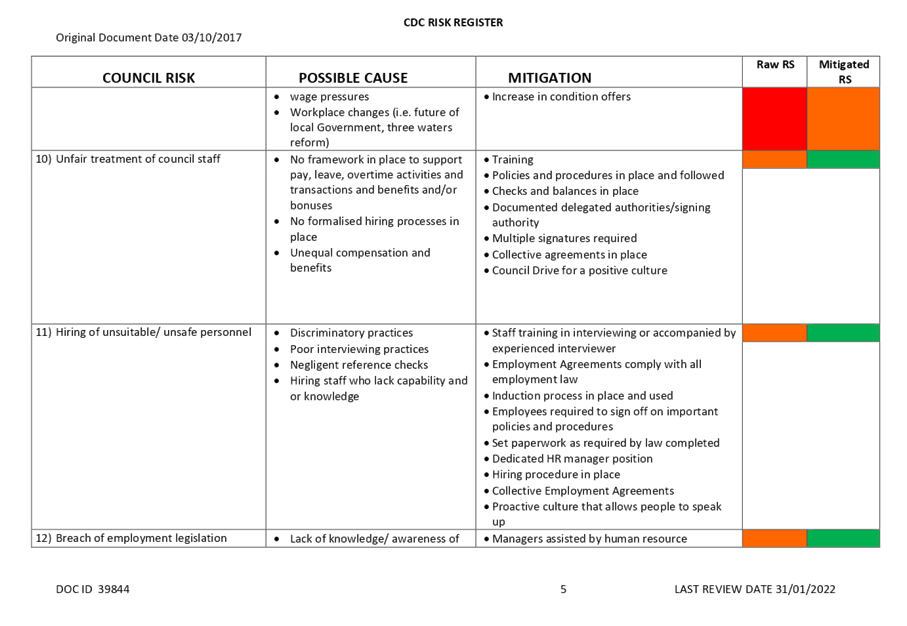
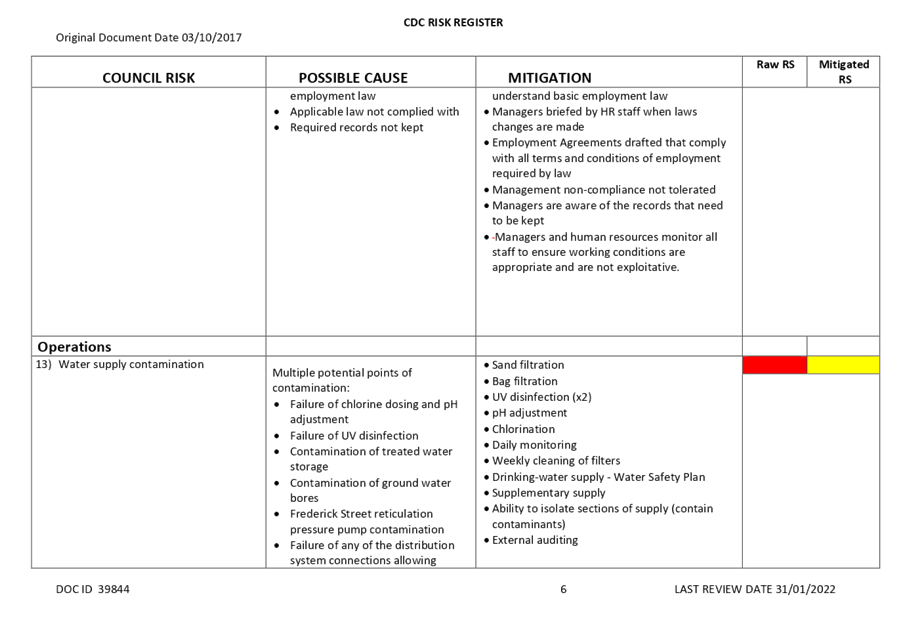
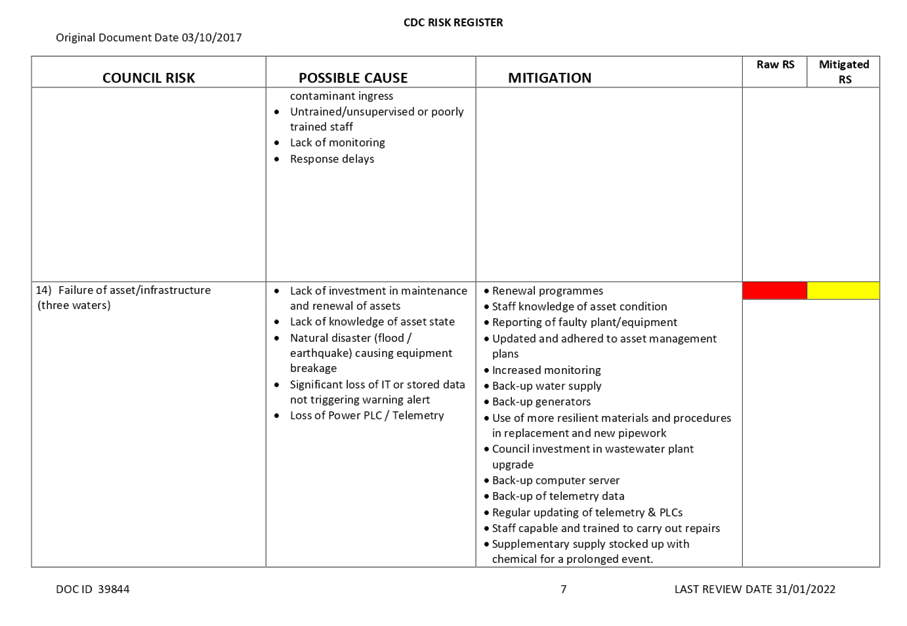
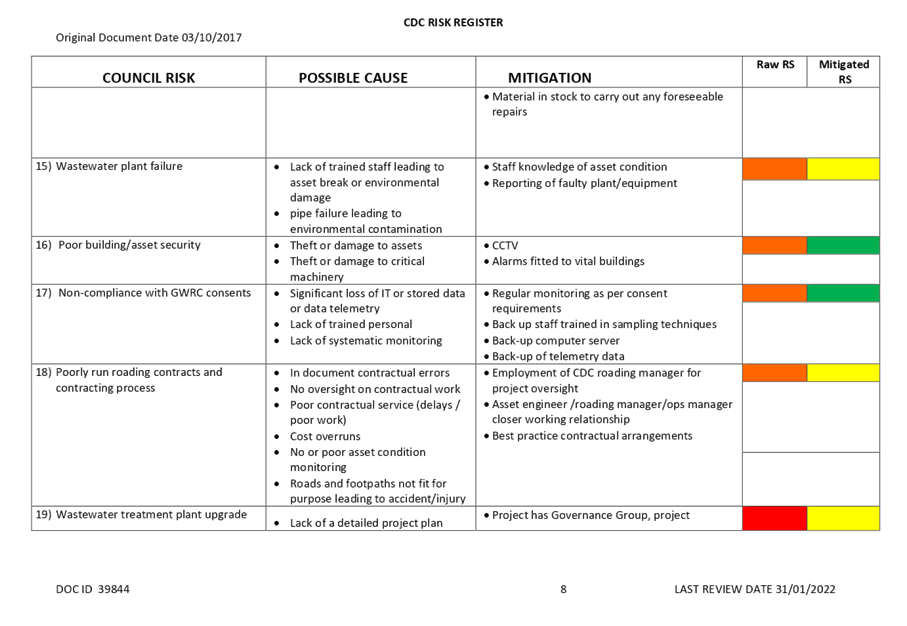
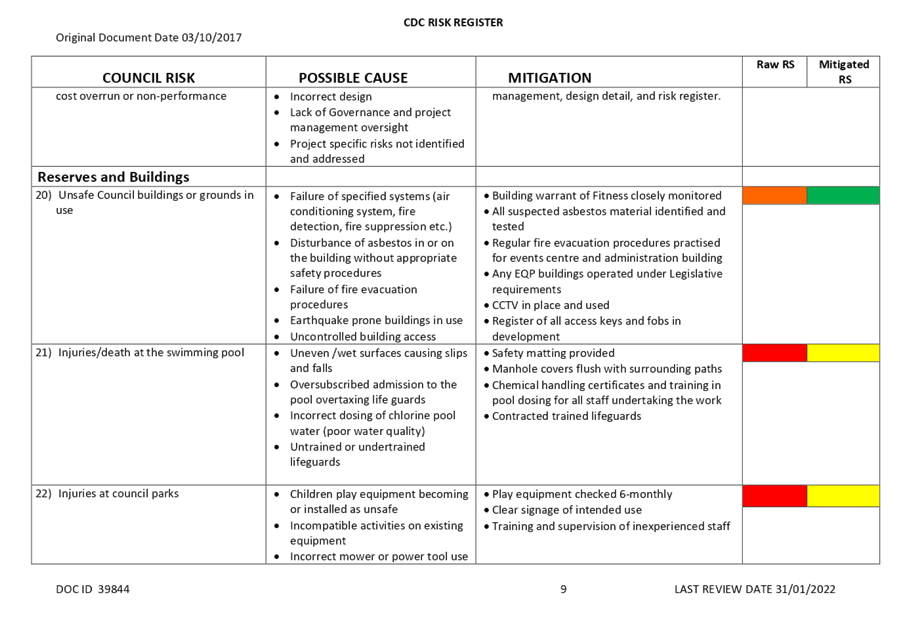
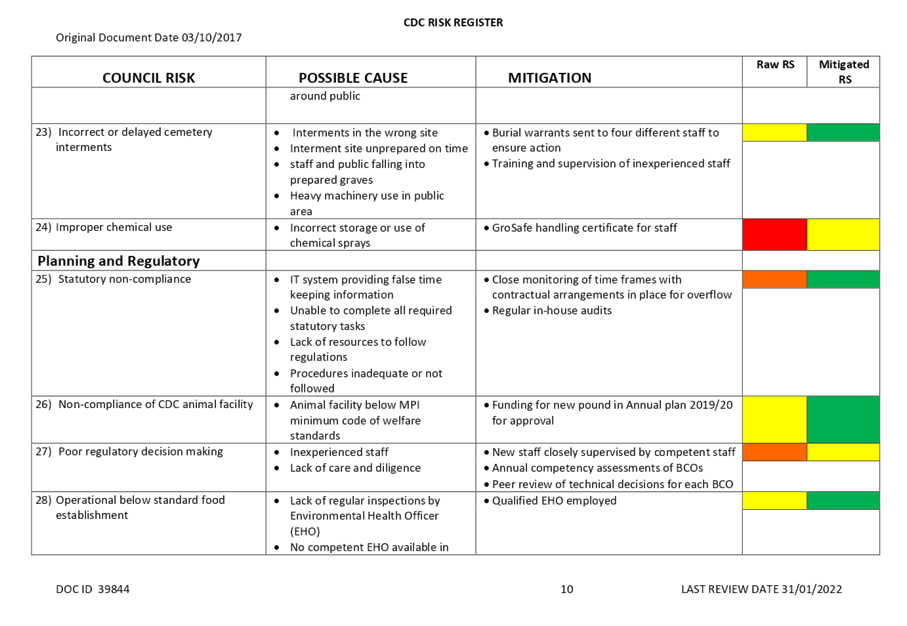
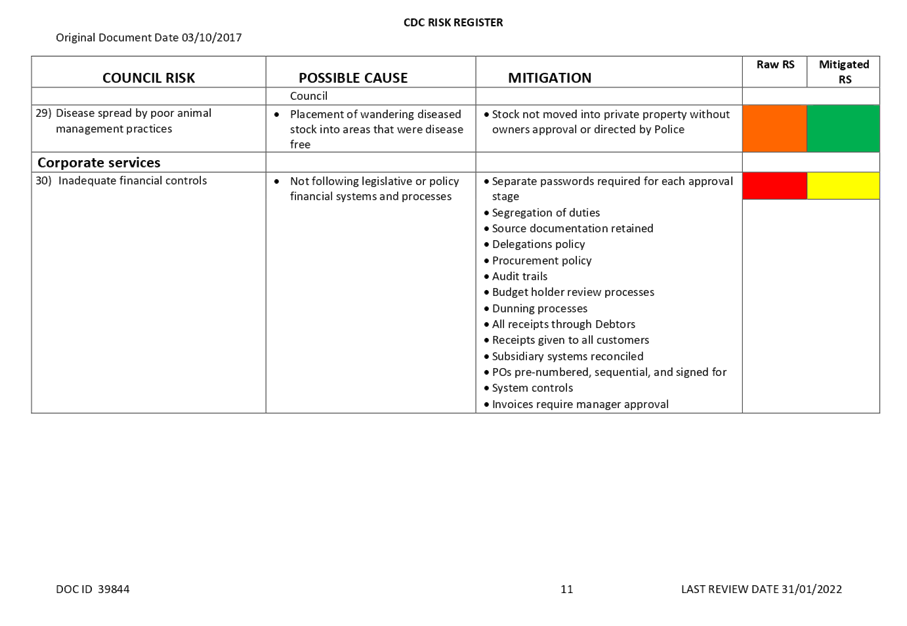
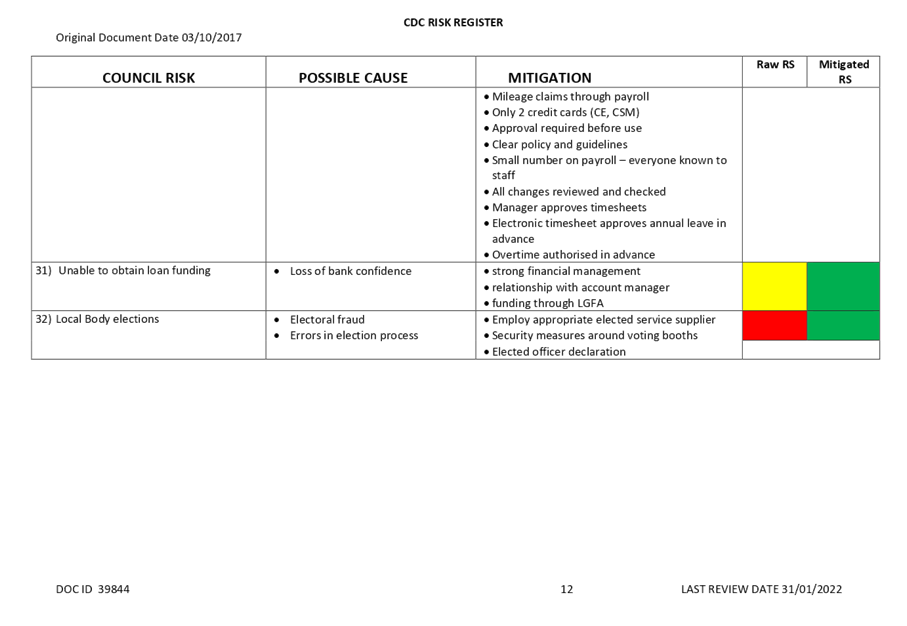

6.9 Health,
Safety and Wellbeing Update
1. Purpose
This report updates
the Audit and Risk Committee on recent health, safety and wellbeing (HS&W)
activities.
2. Significance
The matters
for decision in this report are not considered to be of significance under the
Significance and Engagement Policy.
3. focus
of activities
The main focus for the reporting period, February - April,
has been managing the safe and uninterrupted delivery of services through the
COVID-19 Omicron surge, and increasing the reporting of near miss incidents.
3.1 COVID-19
Service Delivery
Managers and staff
have continued to follow safety protocols and risk mitigations which have to
date, minimised the impacts of positive cases and prevented a widespread
outbreak. The protocols, together with the high vaccination rate of staff
and proactive use of Rapid Antigen Testing (RAT), has meant we have not yet
experienced transmission amongst teams, despite the high number of community
cases.
The move to the Orange
Setting under the COVID-19 Protection Framework (CPF), slightly increased the
risk to staff, particularly with the removal of Vaccine Pass requirements for
the Events Centre and Library, however we have found that the protocols
continue to protect staff well, and the majority of positive cases have likely
been as a result of transmission from their children.
Staff Vaccination
Policy
The Staff Vaccination
Policy was implemented on 28th February 2022. The policy strongly
encourages all employees to receive and maintain vaccination as the main form
of defence against COVID-19, and outlines roles that require mandatory
vaccination:
· Roles subject to a
Public Health Order or the CPF;
· Roles that are
frontline and require staff to deal with members of the public;
· Roles that require
staff to deal with members of the public in uncontrolled environments;
· Roles deemed to
require vaccination as a result of a risk assessment process for health and
safety purposes.
New employees are also
required to be vaccinated.
Following guidance
from Worksafe and Taituarā, management will be
reviewing the policy to ensure it reflects the current risk
environment. There have been some changes to the environment since
the implementation of the policy which include:
· the return to the
Orange Setting under the CPF,
· the reduction of
Wairarapa cases following the Omicron surge,
· the high rates of
vaccination (including booster vaccinations),
· the reduced risk
of reinfection for those who have recently recovered from COVID-19, and
· the available
supply of RAT kits.
Worksafe has stressed
that the justification for requiring vaccination is stronger when the risk of
contracting and transmitting COVID-19 at work is higher than it is in the
community. They recommend a health and safety assessment process that
includes the following factors:
· if there is a
greater risk of the worker being exposed to new variants at work than they
would be in the community,
· whether the worker,
as part of their work, interacts with people who are at greater risk of severe
illness should they contract COVID-19,
· whether the worker
regularly interacts with people who are less likely to be vaccinated,
· if the workspace
is confined within 100m2, and involves close and sustained interactions with
others.
Managers and staff
will undertake a risk assessment of all roles to inform the policy review which
is due for completion by the end of June 2022.
COVID-19 Cases and
Sick Leave
Since 2020, CDC has
operated a flexible sick leave policy designed to ensure staff have sufficient
leave to stay at home when they are unwell. The policy has worked
successfully, particularly in keeping staff with COVID-19 symptoms at home to
prevent any spread through the organisation. There have been no instances
of the policy being misused.
During the current
surge, as expected, we have recorded a number of positive cases amongst the
staff (23 cases = 28% to date) however these have only been sporadic across the
teams, and have usually involved 2-3 cases at any time since the start of the
outbreak in February.
This has resulted in
an increase in sick leave being taken by staff either due to being a positive
case, caring for positive household contacts, or staying home with COVID-19
symptoms but testing negative.
As at 8th
May, 95 days were recorded as sick leave being taken by positive cases.
This is a reduced figure than we may have seen as many staff were able to work
from home if they felt well enough.
3.2 REPORTING
OF NEAR MISS INCIDENTS
Over the past 6 weeks,
managers and team leaders have again focused on ensuring staff report near miss
incidents. The number of reports had reduced markedly over the past 3
months, we believe, largely as a consequence of the disruption of COVID-19.
The proportion of
staff working remotely, combined with a higher incidence of sickness and/or
isolation, has reduced the likelihood of near misses and accidents however, we
believe it has also reduced the front of mind safety awareness for staff.
This is concerning as we know that an absence of near miss reporting increases
the risk of preventable accidents, which we are already starting to see in the
seriousness of the incidents reported.
Managers and team
leaders will continue to emphasise reporting requirements to their teams, and
Health & Safety (H&S) Committee members are leading a permanent H&S
agenda item in team meetings. The HS&W Advisor has also increased
staff engagement to highlight front of mind vigilance including a
re-invigoration of our “Sh!t That Was Close” campaign activities.
4. GENERAL risk monitoring
4.1 HEALTH
AND SAFETY INCIDENTS
For
this period, incidents were reported as follows:
•
2 near miss incidents
•
3 incidents resulting in minor injury
The
H&S Committee and HS&W Advisor have reviewed all incidents and are
satisfied that the responsible managers and team leaders are taking appropriate
actions in each case. None of the accidents have highlighted major
systemic failings.
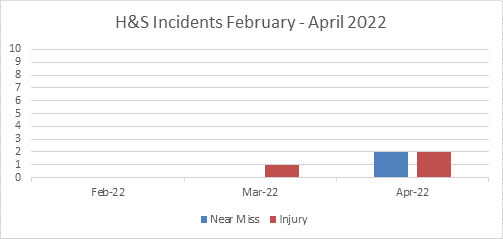
4.2 VEHICLE
SAFETY
Managers and Team Leaders
regularly monitor speed and safe driving behaviour.
Speed Monitoring
While we experienced a
spike in speeds in October, these are now returning to usual levels with a
significant decrease in the last month. We continue to remain below the
national industry average and regular speed reports will continue to be provided
to managers to ensure compliance and follow up of any breaches.
 *Data
is taken from the Argus Tracking System installed in all Carterton District
Council vehicles. The line graph shows risk points per vehicle, comparing
Carterton District Council to the industry average. Risk points are incurred
due to speeding where more speed equals more points, and sustained speed equals
more points.
*Data
is taken from the Argus Tracking System installed in all Carterton District
Council vehicles. The line graph shows risk points per vehicle, comparing
Carterton District Council to the industry average. Risk points are incurred
due to speeding where more speed equals more points, and sustained speed equals
more points.
Policy Review
Staff policies relating to
vehicle and driving behaviour are being reviewed at present. We currently
have three policies that cover these areas – Driver Licensing Policy,
Motor Vehicle Useage Policy, and Safe Driving Policy.
We are looking to combine
and streamline these policies for ease of understanding and compliance by
staff. Engagement with staff will be undertaken during the review.
Road Safety Week
Staff promoted safety
awareness during the week (9 – 13 May) through internal and external
communications, and by wearing yellow on Friday 13th May.
5. engaging with our people
5.1 Health
& Safety (H&S) Committee
The Committee meet bi-monthly to report on HS&W
issues, and to review incidents, near misses and hazards. The Committee remain
well engaged and committed to leading HS&W across the Council. There are
eight members representing all teams across the council and supported by the
HS&W Advisor.
At the recent H&S Committee meeting,
representatives discussed the change of COVID-19 Protocols from the Red traffic
light setting to Orange and the review of the Vaccination Policy and Role Risk
Assessments.
With the expected severe flu season this year,
H&S Committee members have also been instrumental in encouraging their colleagues
to get vaccinated resulting in a large number of staff registering.
5.2 Wellbeing activities
Wellbeing Strategy and Action
Plan
With the CPF setting at Orange,
and the majority of staff now working back onsite, we will be progressing the
Wellbeing Strategy Action Plan. We have started with the activities that
help to reconnect the teams including an all of council staff meeting, and a
social event.
My Everyday Wellbeing
The H&S Committee have endorsed the use of the
“My Everyday Wellbeing” interactive wellbeing platform which will
be available for all staff to access. The website platform has a wide
range of information and activities to increase the wellbeing of staff and
their families. It includes, (but is not limited to), healthy eating including
meal planning and shopping, exercise, illness’s, financial wellbeing and
individual or team challenges. This will be available to staff from 25
May.



Pink Shirt Day
National Pink Shirt Day is about
working together to stop bullying by celebrating diversity and promoting
kindness and inclusiveness. It is about creating a community where all
people feel safe, valued and respected, regardless of gender identity, sexual
orientation, age, ability, religion or cultural background.
Pink Shirt Day is Friday 20th
May and all staff at CDC are encouraged to participate and support the
Kaupapa.

5.3 Training
and Development
One staff member has completed First Aid training,
with a number of staff due to renew their First Aid Certification in
June. Two H&S Representatives completed online Accident and
investigation Training. Both staff members had positive feedback post
training.
One of our new Committee members completed H&S
Representative Stage One training (online), with three other new members booked
to complete this training in May.
5.4 Employee
Assistance Programme
An Employee Assistance Programme (EAP) is a
workplace wellness program designed to boost staff performance by proactively
helping them resolve personal and work issues. The programme offers
confidential and short-term support that assists with a variety of issues,
including financial, legal, physical and mental health. Although
EAP’s are often used for mental health counselling, they can also support
staff in other ways such as career advice and support following a traumatic
event. EAP’s are an essential part of supporting the health and
wellbeing of Council staff, increasing productivity and encouraging a positive
work environment.
Three staff members have accessed EAP services
attending a total of six sessions in this reporting period.
6. WORKING
WITH OUR CONTRACTORS
Reviewing and updating our contractor information is
a focus area, including ensuring COVID-19 protocols and aligned with
Council’s. A biennial audit programme is in place to satisfy
ourselves they understand their obligations, they know what they are doing, and
have competent employees doing it.
While we believe we have a robust contractor
management system in place, this has become outdated and is largely a manual,
spreadsheet-based system. The HS&W Advisor, and the Project,
Contracts and Procurement Officer, attended a meeting to consider other options
including a Contractor Management Programme called SiteWise.
SiteWise is a prequalification system that assesses
contractors’ H&S capability, and publishes that assessment in a
database available to main contractors and principal organisations.
It also records all H&S information, eg
insurances, policies etc, ensuring our contractors have current documentation,
and thus processes, in place at all times. For staff, it provides a robust contractor
selection process, and simplifies the tendering process for everyone involved.
SiteWise is used by many other councils, and there
is no cost involved for CDC.
The Executive Management Team have approved the use
of SiteWise which will be implemented in May, beginning with engagement with
our contractors.
7. FIVE
BIGGEST HEALTH AND SAFETY RISKS
The five biggest Health and Safety risks are listed
with details about how they will be reduced, and when reduction measures will
take place.
Currently the five biggest risks we are focusing on
are:
1. Contractors
2. Working
alone and remotely
3. Under
reporting
4. Behaviour
5. Staff
wellbeing
Top 5 Health and Safety
Risks
|
Risk
|
Description of Risk
|
Controls and reduction measures
|
Actions
|
|
Contractors
|
Council
hires contractors because it doesn’t always have the expertise or
capacity to undertake the activities.
Contractors
pose a risk principally because we have little control over their staff and
their work standards while they are on the job. It is not possible for
us to supervise them at a micro level. We are reliant on them to employ
staff who are trained and competent to undertake the work assigned while at
all times observing safe practices and their obligations under the Health and
Safety at Work Act.
|
All
contractors used by the council will have satisfied us that they have robust
health and safety systems in place and that they understand their health and
safety obligations to us and their staff. Discussions will be held with
contractors before they commence any tasks and staff are expected to have had
and recorded health and safety conversations.
|
Contractors
have been asked to provide details of their health and safety systems.
Information provided is being checked and accredited by council. Approved
providers will be required to sign a contractor agreement. ONGOING
Briefing
and induction processes including hazards and present controls are developed
and are provided to appropriate council staff. COMPLETE
Site
safety Checklists have been developed and are provided to appropriate council
staff. Checklists modified to include what meets expectations and
doesn’t meet expectations. COMPLETE
Staff
have attended the contractor management training.
COMPLETE
Contractor
COVID 19 safety plans and protocols are reviewed to ensure alignment with
council protocols and MOH guidelines.
ONGOING
Implement
the SiteWise Contractor Prequalification and Management Tool to manage
H&S information of contractors.
IN
PROGRESS
|
|
Risk
|
Description of Risk
|
Controls and reduction measures
|
Actions
|
|
Working
Alone and Remotely
|
Being
such a small organisation it is often impossible for staff to work in teams
or even in pairs. Often staff are required to work alone and remotely where
in some cases poor cell phone coverage is an additional factor.
With
the introduction of flexible working arrangements due to Covid-19, we have
staff working from more than we have had in the past.
|
All
staff who work remotely or alone will be provided with in car radio
transmitters and/or cell phones. They will be required to sign out
before they leave, including their intended location and expected time of
return. This will be monitored, and action taken in line with an
emergency response plan if help is summoned or they fail to return by the
expected time. They will be required to sign in when they return.
They will be provided with a device to summon assistance which does not
require cell phone coverage.
Staff
working from home are supported by their Managers/Team Leaders and work
colleagues through Teams meetings/phone calls and emails. Staff are
reminded that the same obligations to Health and Safety apply when working
from home.
|
All
staff who work remotely or alone have a car radio transmitter and/or cell
phone and/or a Garmin device. COMPLETE
Sign
out/in system has been reviewed. COMPLETE
Monitoring
of sign out/in system in place. COMPLETE
Remote
contact devices have been distributed to teams who have people who work alone
or remotely. We will continue to work with the teams on monitoring team
members when they are out and about and using the information from the Garmin
device.
ONGOING
Garmin
refresher training, and Working Alone refresher training will be co-ordinated
in house with those staff that work alone.
ONGOING
Staff
are reminded of our Working from Home Policy, Workstation set up guide,
Incident Report and EAP services.
ON
GOING
|
|
Risk
|
Description of Risk
|
Controls and reduction measures
|
Actions
|
Under
Reporting
|
While
there is a good level of reporting any physical accidents, the risk of
under-reporting of near misses needs to be constantly monitored.
This
is due to a combination of staff thinking “nothing happened so why
report it” and the perceived amount of time required to make a report.
|
We
regularly remind staff of the importance of notifying any near miss so that
we are able to both consider patterns and to take pre-emptive action to put
in place safety measures where necessary. Wherever possible are making
it easier for staff to report near misses.
|
We
have provided all Operations staff with a pocket-sized notebook to instantly
record near misses. COMPLETE
The
“Sh!t That Was Close” initiative is a descriptor of a near miss
that is relevant to our staff who are the most likely to observe such
things. We have a designated email address stwc@cdc.govt.nz
and text number set up to make it easy for staff to communicate health and
safety matters. ONGOING
Managers
and Team Leaders are backing the reporting message at team meetings through a
formal agenda item, talking about near misses and reminding staff to report
those that they see. ONGOING
Health
and Safety Committee members take an active role in encouraging all incident
reporting, including near miss reporting within their teams and across
Council. ONGOING
Near
miss reporting , the STWC email and H and S phone number are being promoted
through posters, fortnightly staff newsletter and the TV monitors in the
staffrooms. ONGOING
Health
and safety obligations are included in employment agreements and job
descriptions. ONGOING
The
importance of timely reporting is emphasised during health and safety staff
induction processes ONGOING
|
|
Risk
|
Description of Risk
|
Controls and reduction measures
|
Actions
|
|
Behaviour
|
An
unintended consequence of changes in our environment has seen Carterton
district council having to manage situations where people’s behaviours
pose a risk of somebody threatening or assaulting them, possibly with a weapon.
With potential of a fatality.
Introduction
of a range of services and experiences such as Wi-Fi, together with
external environmental factors such as transition of mental health patients
into the community, troublesome youth, drug and alcohol abuse have potential
to result in an increase in problematic individuals frequenting CDC premises
and dealing with CDC staff in the community.
Cash
held on premises also presents potential for robbery.
Negative
behaviour from customers objecting to COVID-19 restrictions and mandates.
|
It
is important all our staff know how to keep themselves and others safe when
dealing with each other and members of the public. Skilled staff are able to
deal with interactions with difficult customers, before they escalate to
situational violence. We need to provide all staff with training to give them
the skills to deal with situations before they escalate to harm.
We
need to ensure there are appropriate security measures in place to protect
staff from persons entering premises with the intent of causing harm. This
includes equipping people working in our community with cameras and
communication devices.
We
need to continue migration of customers to payment mechanisms that do not
rely on cash.
Concern
for underreporting of near misses involving people’s behaviour, is
being addressed separately. The risk of threats or violence to staff working
alone or in remote areas is also being addressed separately.
|
Restrict
public access to secure staff only areas. Ensure staff escorts visitors to
non-public areas in all three council sites. ONGOING
Undertake
regular engagement with Police, community patrol groups and community groups
supporting youth and mental health to ensure an awareness of what is
happening in the community with potential to impact Council staff and
others. ONGOING
Staff
are provided with training covering Personal safety, Conflict Resolution,
Cash Handling and Robbery Preparedness. In the Staff Handbook, we have
guidelines and tools to assist staff when dealing with difficult people.
ONGOING
We
have seen continued uptake of payment of accounts online or by direct debit
with over 60% of ratepayers now paying rates by direct debit, with others
paying through online banking and automatic payment.
We
have set up an online payment portal and we will continue to encourage people
to pay online. COMPLETE
We
are fostering a healthy and safe team culture through gender balance, more
robust onboarding process and the implementation of the CDC Wellbeing
Strategy. We are promoting a culture where staff feel safe raising any
concerns, and know their concerns will be addressed appropriately. ONGOING
During
the COVID-19 pandemic we have monitored incidents involving negative
behaviour associated with objections to COVID-19 restrictions and
mandates. Frontline staff have been provided with guidelines and
resources to manage challenging behaviour. Managers are on hand to
provide support where required.
ONGOING
|
|
Risk
|
Description of Risk
|
Controls and reduction measures
|
Actions
|
|
Staff
Wellbeing
|
Being
a small organisation and having departments under-staffed is placing some
teams under pressure and the need to work long hours. Staff under
pressure pose a risk to themselves, the organisation, and customers.
Staff under pressure can lead to burnout, stress, fatigue, all leading to
both mental/physical and social affects, contributing to lower performance
levels.
Working
long hours under pressure can lead to poorer mental health including
stressful feelings, an increase in anxiety, depression and lower quality
sleep patterns. This will contribute to a higher number of accidents
occurring, bad decisions being made, irritability and concentration/memory
issues.
Employees
physical health can be compromised with the increased risk of a stroke, heart
problems, high cholesterol and high blood pressure.
|
Managers
and staff need to be able to recognise the early symptoms of stress, fatigue
and burnout.
We
need to ensure we have an environment where staff feel they are trusted and
can talk with their manager or a senior staff member about how they are
feeling.
Stress
awareness, fatigue information and the symptoms of burnout will be
communicated to all staff so early symptoms can be recognised across the
team.
Staff
will be reminded of the free and confidential counselling service offered
through EAP.
Clearly
defined position descriptions and resourcing are key for reducing this
risk. Clearly defined boundaries and jobs that are achievable.
Managers and Team Leaders to encourage their teams to take adequate breaks
and keep tabs on work hours to ensure they do not exceed 55 hours in a week
as per our “Hours of Work and Fatigue Policy” ID 42072.
|
Development
of staff Wellbeing Strategy and action plan. COMPLETE
Implementation
of flexible sick leave policy. COMPLETE
Good
mental health, stress awareness, fatigue information and good wellbeing is
communicated to all staff through posters, T.V. screen notices, and the
fortnightly staff newsletter. ONGOING
Managers
and team leaders regularly check in with their teams and provide support
where needed. ONGOING
EAP
information communicated to all staff through posters and the fortnightly
staff newsletter. ONGOING
New
screens installed in the lunchroom to provide wellbeing and health and safety
messages.
IN
PROGRESS
Work
with other councils to combine services and/or provide relief staff. ONGOING
Filling
of vacant roles. ONGOING
Address
lack of work-space issues through physical relocation, working from home
flexibility where appropriate, re-design of existing spaces. ONGOING.
|
|
Audit
and Risk Committee Meeting Agenda
|
19
May 2022
|
8. CONSIDERATIONS
8.1 Climate
change
None
of the issues reported in this paper are considered to have climate change
implications.
8.2 Tāngata whenua
There
are no decision implications for tāngata whenua.
8.3 Financial
impact
All
work undertaken is within planned budgets.
8.4 Community
Engagement requirements
No
community engagement is required.
8.5 Risks
There are no decisions required in this report.
9. Recommendation
That the Committee:
1. Receives
the report.
File
Number: 138854
Author: Geri
Brooking, People and Wellbeing Manager
Attachments: Nil
|
Audit
and Risk Committee Meeting Agenda
|
19
May 2022
|
|
Audit
and Risk Committee Meeting Agenda
|
19
May 2022
|
7 Exclusion
of the Public
RESOLUTION TO
EXCLUDE THE PUBLIC
|
Recommendation
That the public be excluded from the following parts of
the proceedings of this meeting.
The general subject matter of each matter to be considered
while the public is excluded, the reason for passing this resolution in
relation to each matter, and the specific grounds under section 48 of the
Local Government Official Information and Meetings Act 1987 for the passing
of this resolution are as follows:
|
General subject of each matter to be considered
|
Reason for passing this resolution in relation to each
matter
|
Ground(s) under section 48 for the passing of this
resolution
|
|
7.1 - Chief Executive Interim Performance Review
2021/2022
|
s7(2)(a) - the
withholding of the information is necessary to protect the privacy of
natural persons, including that of deceased natural persons
|
s48(1)(a)(i) - the
public conduct of the relevant part of the proceedings of the meeting would
be likely to result in the disclosure of information for which good reason
for withholding would exist under section 6 or section 7
|
|


























































































